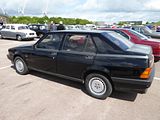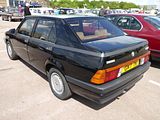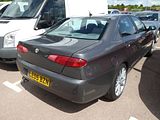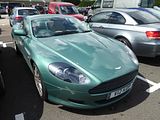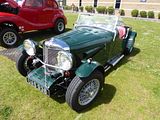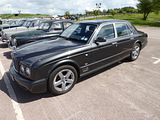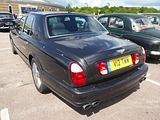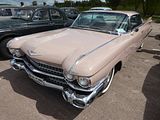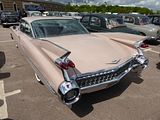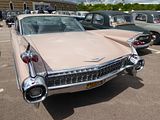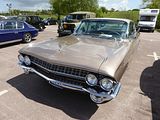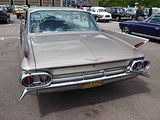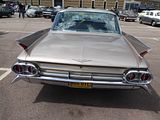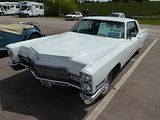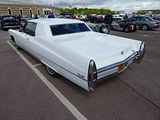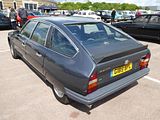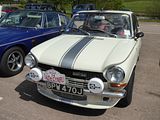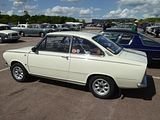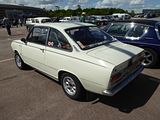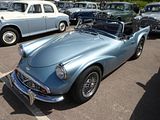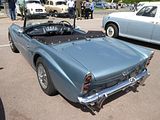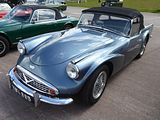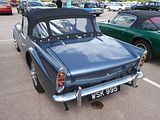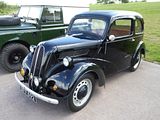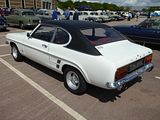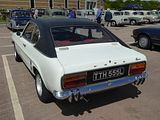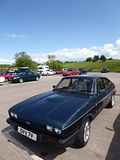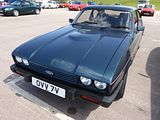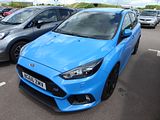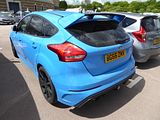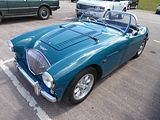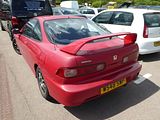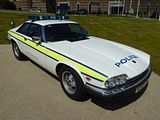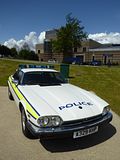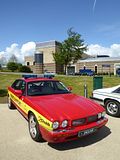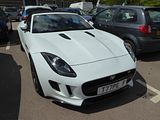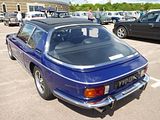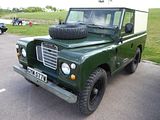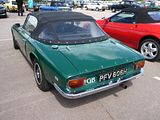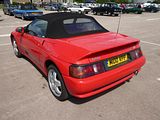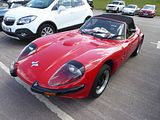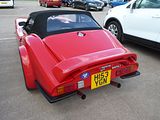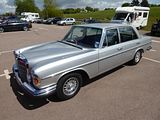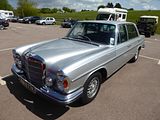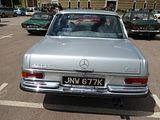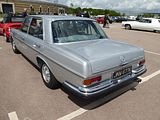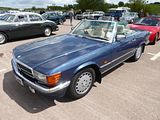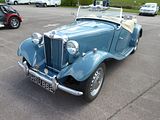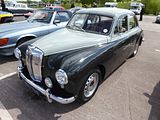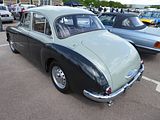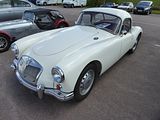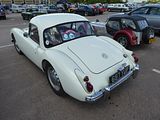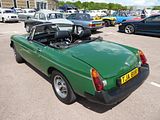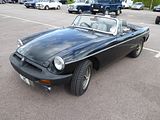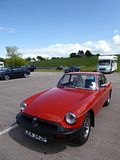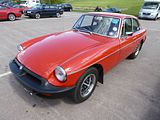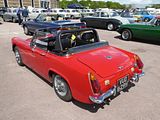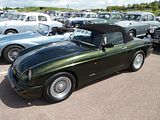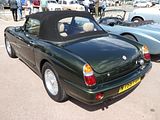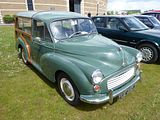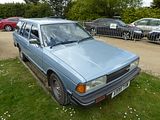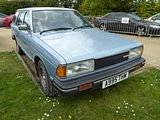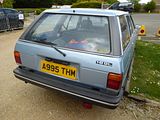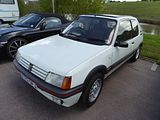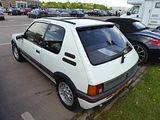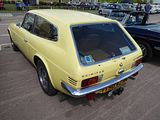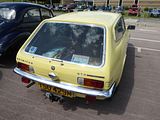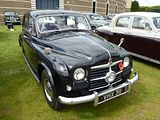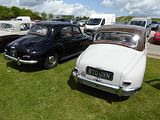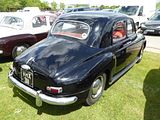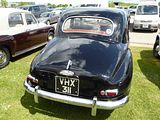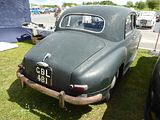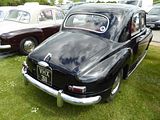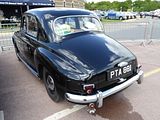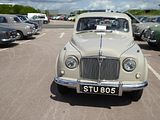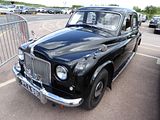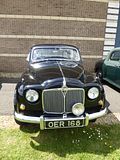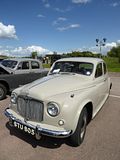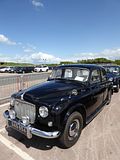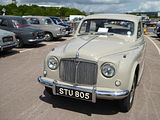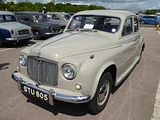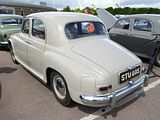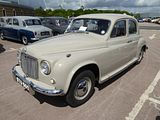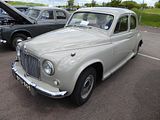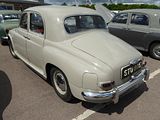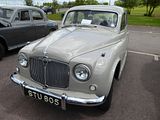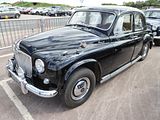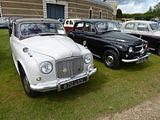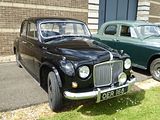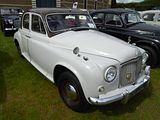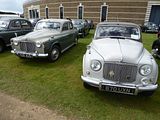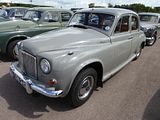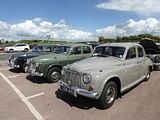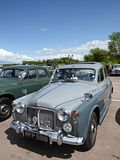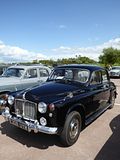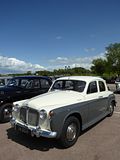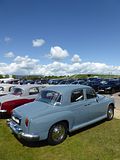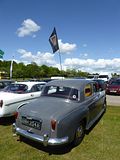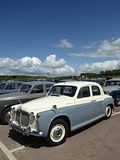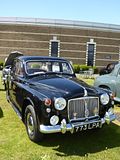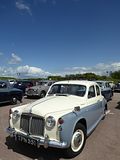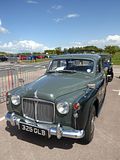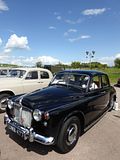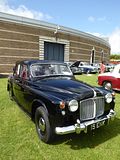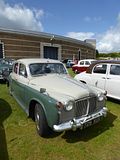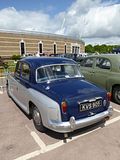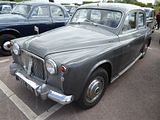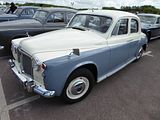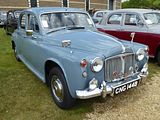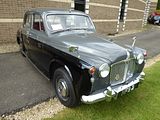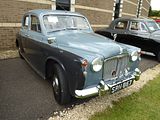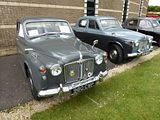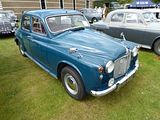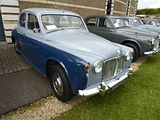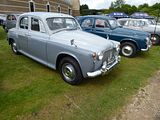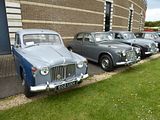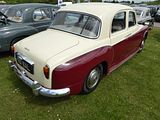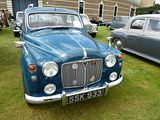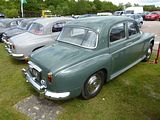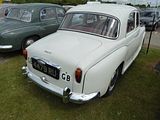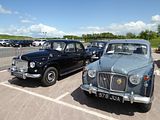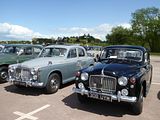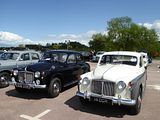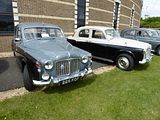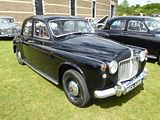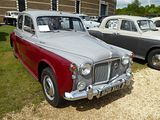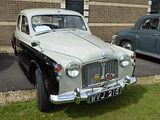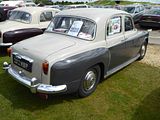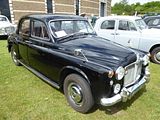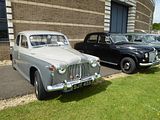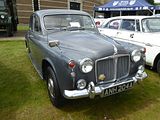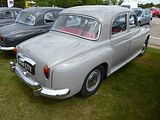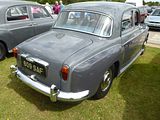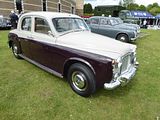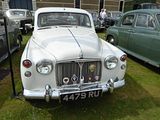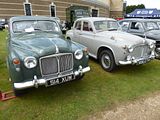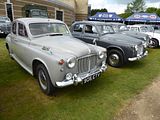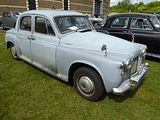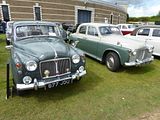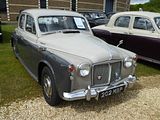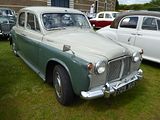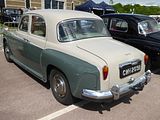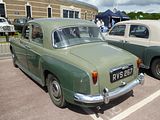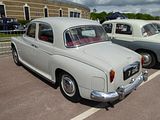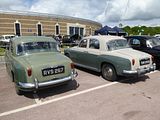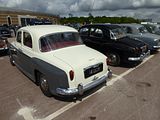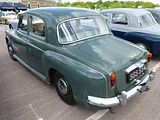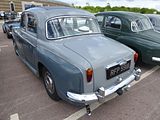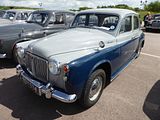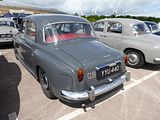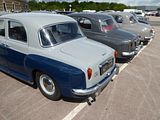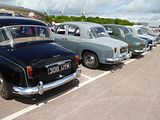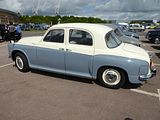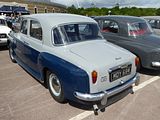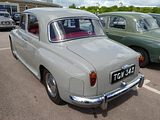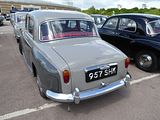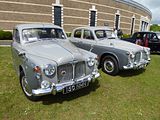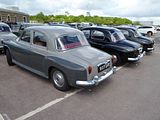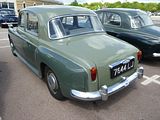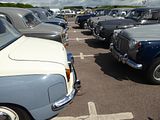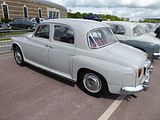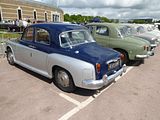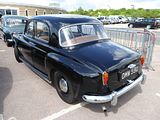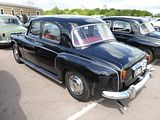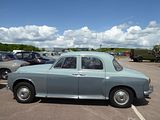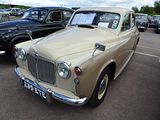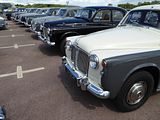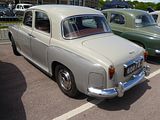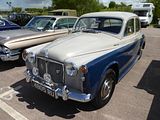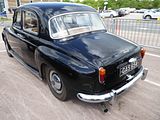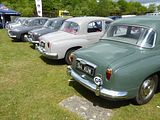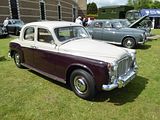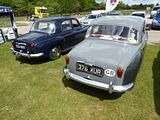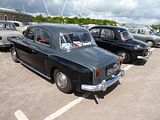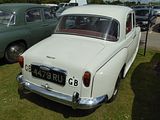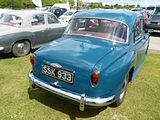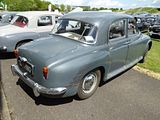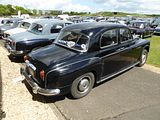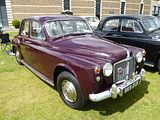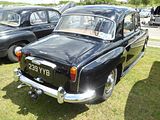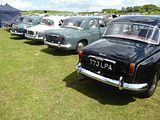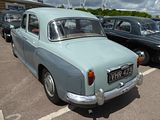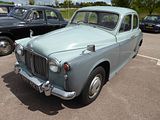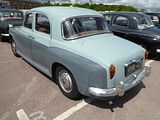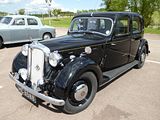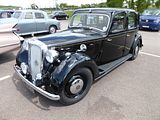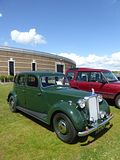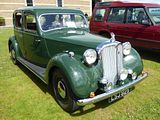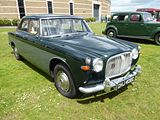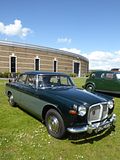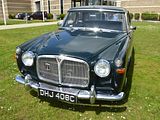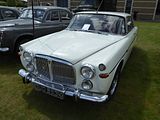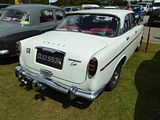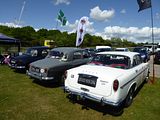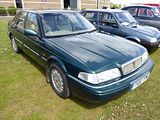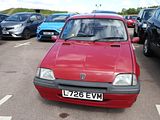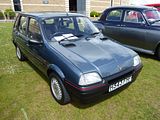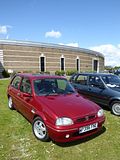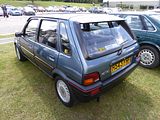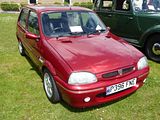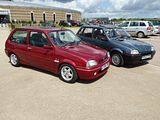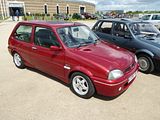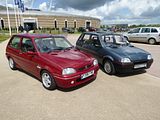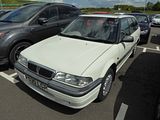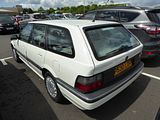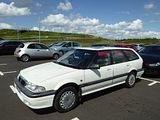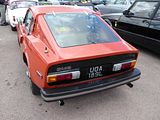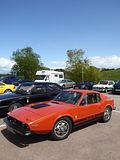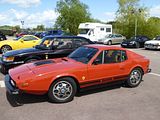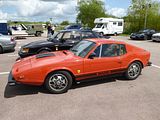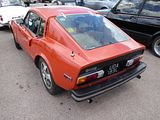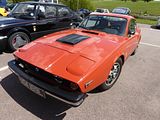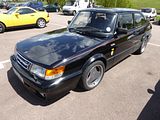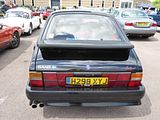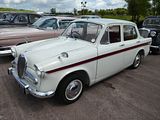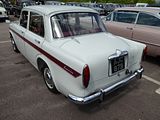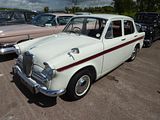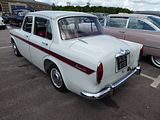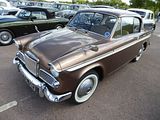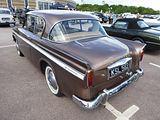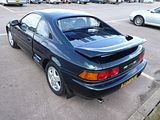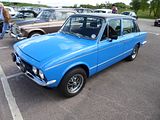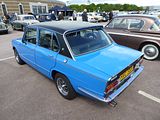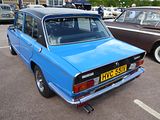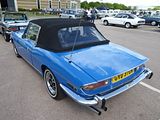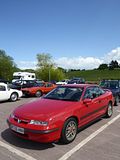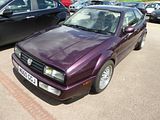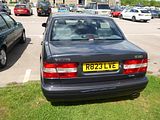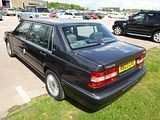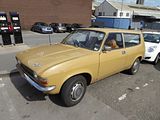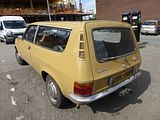By the time you get to May, there are large numbers of car events on every weekend across the UK, so you problem is not whether there is something to go to, but to choose which one you plan to attend. I deliberated long and hard over what to do on the second weekend of the month, with the possibility of Breakfast Clubs both in Bristol and at Shelsley Walsh (these clash every month), and a Rotary Club organised meeting at Prescott Hill Climb which always attracts an eclectic bunch of classics all being possible contenders, but in the end decided to head to what is now branded the British Motor Museum, at Gaydon, for their Spring Classic event. I’ve been to this a few times in the past, and know that it is not massive in scale, but it always attracts a diverse array of cars with some of the sort of classics that you see at almost any British event as well as few oddities that you very rarely do encounter. This venue had the added attraction that if the weather were turn against the event, which the forecast suggested it might, or might not, then there is always the sanctity of the museum for shelter, and in fact, I’ve not yet explored the museum since its relaunch early in 2016. Pausing at the Warwick Services area on the M40 before getting there, I spotted at least three examples of the Rover P4 in a car park which was otherwise packed with fans all wearing blue and white in support of Tranmere Rovers who were in the play-offs at Wembley that afternoon. They were all clearly excited, and having got my first taste of what was likely to be at Gaydon, so was I. On arrival, the marshalls were separating cars for the event from those they wanted in general parking. Needless to say, I was pointed at the latter, as was anything that was a recent car, which meant that there were actually a few interesting cars in the main car park as well as those which were deemed to constitute the event itself. I have included the pictures of those cars in the general report. So here is what there was to see.
ALFA ROMEO
This was definitely not the event to attend if you wanted to see Italian cars, as, ignoring the “ordinary” cars in the main car park, there were only two here, both of them Alfa Romeos. The one that was actually in the display was a 3.0 litre Alfa75, which bears the badging 6V Iniezione on the back. The 75 was the last Alfa model to be developed before the company was bought by Fiat. It was introduced in May 1985, to replace the 116 Series Giulietta with which it shared many components and was named to celebrate Alfa’s 75th year of production. The body, designed by head of Alfa Romeo Centro Stile Ermanno Cressoni, was styled in a striking wedge shape, tapering at the front with square headlights and a matching grille. The 75 was only ever sold as a four door saloon, though at the 1986 Turin Auto Salon, a prototype 75 estate was to be seen, an attractive forerunner of the later 156 Sportwagon. Dubbed the 75 Turbo Wagon, it was made by Italian coachbuilder Rayton Fissore using a 75 Turbo as the basis. Two estate versions were to be found at the later 1987 Geneva Motor Show; one was this Turbo Wagon and the other was a 2.0 litre version named the Sportwagon. This version was sadly cancelled after Fiat took control of Alfa Romeo The 75 featured some unusual technical features, most notably the fact that it was almost perfectly balanced from front to rear. This was achieved by using transaxle schema — mounting the standard five-speed gearbox in the rear connected to the rear differential (rear-wheel drive). The front suspension was a torsion bar and shock absorber combination and the rear an expensive de Dion tube assembled with shock absorbers; these designs were intended to optimize the car’s handling; moreover the rear brake discs were fitted at the centre of the rear axle, near the gearbox-differential group. The engine crankshaft was bolted directly to the two-segment driveshaft which ran the length of the underside from the engine block to the gearbox, and rotated at the speed of the engine. The shaft segments were joined with elastomeric ‘doughnuts’ to prevent vibration and engine/gearbox damage. The 2.0 litre Twin Spark and the 3.0 Litre V6 were equipped with a limited slip differential. The 75 featured a then-advanced dashboard-mounted diagnostic computer, called Alfa Romeo Control, capable of monitoring the engine systems and alerting the drivers of potential faults. The 75 engine range at launch featured four-cylinder 1.6, 1.8 and 2.0 litre petrol carburettor engines, a 2.0 litre intercooled turbodiesel made by VM Motori, and a 2.5 litre fuel injected V6. In 1986, the 75 Turbo was introduced, which featured a fuel-injected 1779 cc twin-cam engine using Garrett T3 turbocharger, intercooler and oil cooler. In 1987, a 3.0 litre V6 was added to the range and the 2.0 lire Alfa Romeo Twin Cam engine was redesigned to have now two spark plugs per cylinder, the engine was named as Twin Spark. With fuel injection and variable valve timing this engine produced 146 hp. This was the first production engine to use variable valve timing. In North America, where the car was known as the Milano, only the 2.5 and 3.0 V6s were available, from 1987 to 1989. The North American 2.5-litres were fundamentally different from their European counterparts. Due to federal regulations, some modifications were required. Most noticeable from the outside were the ‘America’ bumpers, with the typical rubber accordions in them. Furthermore, these bumpers had thick (and heavy) shock-absorbing material inside them and in addition, they were mounted to the vehicle on shock absorbers. To accommodate these shock absorbers, the ‘America’-bodies were slightly different from the European ones. The North American cars also had different equipment levels (depending on the version: Milano Silver, Milano Gold or Milano Platinum). electrically adjustable outside mirrors, electrically reclining seats and cruise control were usually optional in Europe. The car was also available with a 3-speed ZF automatic gearbox option for the 2.5 V6. Other, more common options such as electrically operated rear windows and an A/C system were standard in the USA. The USA-cars also had different upholstery styles and of course different dashboard panels also indicating speed in mph, oil pressure in psi and coolant temperature in degrees F, and as a final touch the AR control was different, including a seat belt warning light. The European-spec 2.5 V6 (2.5 6V Iniezione or 2.5QV) was officially sold only between 1985 and 1987, although some of them were not registered until 1989. Relatively few of them were sold (about 2800 units), especially when the 155 PS 1.8 Turbo was launched, which in some countries was cheaper in taxes because of its lower displacement. To create a bigger space between the V6 and the inline fours, the 2.5 was bored out to 2959 cc’s to deliver 188 PS and this new engine was introduced as the 3.0 America in 1987. As its type designation suggests, the 3.0 only came in the US-specification, with the impact-bumpers and in-boot fuel tank. However, the European ‘America’s’ were not equipped with side-markers or the door, bonnet and boot lid fortifications. Depending on the country of delivery, the 3.0 America could be equipped with a catalytic converter. In 1988 engines were updated again, the 1.8 litre carburettor version was replaced with fuel injected 1.8 i.e. and new bigger diesel engine was added to the range. In the end of 1989 the 1.6 litre carburettor version was updated to have fuel injection and 1990 the 1.8 Turbo and 3.0i V6 got some more power and updated suspension. The 3.0 V6 was now equipped with a Motronic system instead of an L-Jetronic. The 1.8 Turbo was now also available in ‘America’-spec, but strangely enough not available for the USA market. The 3.0 V6 did make it to the United States, and was sold as Milano Verde. The UK never particularly warmed to the 75 when it was new, but its reputation has got ever stronger as the car ages. Many UK cars were snapped up by the owners of driving schools at racing circuits, thanks to its handling characteristics, but there are also some nice road cars left and this was definitely one of them.
The other Alfa to catch my eye was a 166, which was in the main car park. The 166 followed the much lauded 156, which had been launched eighteen months prior, and with it, Alfa were hoping to receive the same sort of acclaim with this executive car which was a direct replacement for the 164. It was not forthcoming. For a start, the styling with its drooping and very small headlamps and pointed nose was quite unlike anything else on the market at the time. Part of the difficulty came from the fat that the car had been designed some years before its launch and then put on the back burner as the 156 was given priority. The 166 was initially available with a 155 PS 2.0-litre Twin Spark, a 190 PS 2.5 V6, a 220 PS 3.0 V6 and in some markets a 205 PS V6 2.0 Turbo petrol engine along with a diesel powered L5 2.4 10v common rail turbodiesel version with 136 PS, 140 PS and 150 PS (148 hp) output. The 2.0 TS model used a 5-speed manual gearbox, whilst the 2.5 and 3.0 had the option of a Sportronic automatic gearbox. The 3.0 V6, L5 2.4 and V6 Turbo were otherwise supplied with a six-speed manual gearbox. The top models were named “Super”, and included MOMO leather interior, 17″ alloy wheels, rain sensitive wipers, cruise control, climate control and ICS (Integrated Control System) with colour screen. Options included xenon headlamps, GSM connectivity and satellite navigation. Suspension systems comprised double wishbones at the front and a multi-link setup for the rear. Though the car’s handling characteristics, engine range and elegant exterior design received praise from many, including Top Gear’s Jeremy Clarkson, it did not become a strong seller to rival the dominant German brands, in the European executive car sector. In September 2003, the 166 underwent a substantial revamp, with the début at the Frankfurt Motor Show. As well as upgrades to the chassis, interior, and the engine range, the styling was substantially altered. The new front end resembled the also recently revamped 156, and lost its famous drooping headlights. The 2.0 V6 Turbo model was dropped because of marketing problems, the V6 2.5 was re-rated at 188 PS and a 3.2 litre V6 with 240 PS was introduced. Both the 3.2 litre and the 2.0 Twin Spark models now featured the six-speed manual gearbox, whilst the 3.0 model was retained, but made available only in Sportronic form. In the diesel sector, the L5 2.4 was re-engineered with Multi-Jet technology which allows up to 5 injections per cycle, second stage common rail, with maximum injection pressure of 1400 bar and 4 valves per cylinder, to output a class leading 175 PS, but these changes made little impact on sales volumes. In October 2005, the Alfa Romeo 166 was officially withdrawn from sale in markets for RHD. Sales of the 166 never grew as Alfa had hoped, following the facelift in September 2003, and the additional lack of a diesel engine in the United Kingdom, Australian, and Irish markets limited its reach into company car sectors. In June 2007, production of the 166 effectively ended, with no direct successor. In September 2008, the platform was sold to the Chinese state run manufacturer GAC Group. In total, less than 100,000 units were made, and there are not that many left in the UK now.
ASTON MARTIN
Both the Aston Martin models that I found here were also consigned to the main car park. These were a DB9 and a V8 Vantage.
AUSTIN-HEALEY
This one would have had me stumped were it not for the small Austin Healey badges on the front below the radiator grille. I assume it is a Special, built on an Austin Healey chassis, but have found nothing more about since the event, from the great Google, and indeed only a couple of pictures where the car was seen at a Bicester Heritage Sunday Scramble.
BENTLEY
This is an Arnage, a twin of the Rolls-Royce-branded sibling, the Silver Seraph, which were introduced in the Spring of 1998, the first entirely new designs for the two marques since 1980. This is a large car: over 5.4 meters (212 in) long, 1.9 metres (75 in) wide, and has a kerb weight of more than 2.5 metric tonnes. For a brief period it was the most powerful and fastest four-door saloon on the market. In a complete switch from tradition, whilst these cars had bodies built at the Crewe factory, the then owner, Vickers, decided that the car would be powered by engines built elsewhere. A number of potential engines were examined, including the GM Premium V engine, and a Mercedes-Benz V8 engine, before, in late 1994, Vickers selected a pair of BMW power plants. It was decided that the Rolls-Royce model would use BMW’s naturally aspirated V12 engine while the more-sporting Bentley model would use a special twin-turbo version of the 4.4-litre BMW V8, which was developed by Vickers subsidiary, Cosworth Engineering. On its introduction in the spring of 1998, the Arnage was available as a single model with the this 4,398cc twin turbo developing some 354 PS (349 bhp) and 420 lb·ft. During the takeover battle in 1998 between BMW and Volkswagen Group for ownership of Rolls Royce and Bentley Motors, BMW had threatened to stop supply of their engines if Volkswagen Group won. While the threat was later withdrawn in conjunction with BMW acquiring the right to manufacture the Rolls Royce marque at a new location, it was clear that Volkswagen could not accept the business and reputation risks associated with having their rival as a long-term business partner. Furthermore, customers were nervous about engine and part availability (of which there turned out to be no issue) and orders for new cars dropped precipitously. Volkswagen’s response was to prepare the old pushrod 6.75-litre 16-valve engine from the Turbo R for the Arnage, designed for the lighter and smaller BMW 32-valve V8 unit. Coupled with an outdated 4-speed automatic, the engine was extremely thirsty, and would not meet government-imposed emissions standards without hasty modifications.The revised version of the car was launched as the Arnage Red Label in October 1999. At the same time, but without the fanfare, Bentley made several minor modifications to the original BMW engined cars, and designated them as the “Arnage Green Label” for the 2000 model year. As part of the modification process, both Red and Green Label cars received stiffer body shells and larger wheels and brakes. The stiffer body shell was needed because of the extra weight of the British engine. The larger brakes were needed for the same reason. Despite the larger brakes, braking performance worsened with the extra weight of the 6.75 engine. The braking performance of the ’99 Green Label from 70–0 was 172 feet while the later Arnage T’s performance was 182 feet from the same speed. The PR department at Bentley pointed to customer demand as the driving force behind the reversion to the old two valve per cylinder 6.75-litre unit for the Red Label. This explanation appears to have been acceptable to all but a few of the motoring press who welcomed the return of the old unit after criticising the BMW motor as at best insipid and, at worst, underpowered. In reality, the outgoing BMW-powered Arnage was technically more modern, considerably more fuel efficient, and had 32 valves with double overhead camshafts, twin-turbo and Bosch engine management technology – as opposed to 16-valve, single turbo and a pushrod motor with less advanced engine management. The Red Label’s increase in motive power shaved less than a second of the zero to 60 mph time. However, the BMW twin turbo unit remained noticeably more agile and responsive from a driver’s perspective, due to its more responsive DOHC engine, better weight balance(maintaining a 51.1/48.9 weight distribution) and almost 600 lb (270 kg) lower curb weight. Ultimately the Green Label was more reliable and significantly less expensive to service in the long term. The key limiting factor of the BMW engine’s output was the ZF 5HP30 transmission which was not rated to handle more than the 413 lb·ft torque that the twin turbo engine was tuned to produce. In total only seven Arnage Green Label units were built, all of which were left-hand-drive versions. There was a final series of vehicles built in 2000 with the 4.4-litre BMW engine designated the Arnage Birkin, of which 52 units were produced and are distinguishable by their three-dial as opposed to five-dial instrument centre dashboard configuration. A long-wheelbase version of the Red Label was launched at the North American International Auto Show in 2001. The Green Label ended production in 2000. The Red Label models were replaced in 2002. In 2001, the Arnage RL, a long-wheelbase model, 9.8 in longer than the Arnage, was launched, the extra length added to the car at its rear doors and its C-pillar. With the standard Arnage model, the rear wheel wells butt up against the rear door frames, but with the RL they are a few inches further back. The overall effect is a larger rear area inside the car. Available only as a bespoke “Mulliner” model, each RL was customised to the desires of the buyer. The RL, however, was also the first of a new series of Arnages which would finally cure the Bentley Arnage of the reliability and performance deficiencies experienced following its forced deprivation of the modern BMW engines it was designed to use. The RL would also present a credible challenge to BMW’s attempts to revive the Rolls-Royce brand with its planned new model, the Phantom. The RL’s introduction saw the introduction of an entirely reworked version of the 6.75-litre V8 engine. Where the engine used in the Red Label was a quickly and less-than-completely-satisfactorily modified version of the Turbo RT’s unit, the RL featured an entirely reworked version of the old 6.75-litre V8. More than half of the engine’s parts were completely new, with Bosch Motronic ME7.1.1 engine management replacing the old Zytek system, and two small Garrett T3 turbochargers replacing the single large T4. This new engine developed 405 PS (399 bhp) and 616 lb·ft, and was said to be capable of meeting all future emissions requirements. Finally, the Arnage was powered by a modern twin-turbo unit with state-of-the-art electronic management system similar to the originally Cosworth-BMW unit developed for the Arnage in 1998. Perhaps ironically, what was essentially a new engine developed by Volkswagen Group engineers for the RL in 2001, was now producing the same sort of power as the original BMW V8 4.4 engine used in the first Arnage in 1998. Unfortunately, the development and testing of the revisions to the new engine were rushed by VW to meet regulatory requirements. As a result, the camshafts are prone to failure requiring extensive repair work to remedy In 2002, Bentley updated the Red Label as the series two Arnage R. This model was launched to contrast the Arnage T, which was developed to be more sporting. The Arnage R features two Garrett T3 turbochargers, as with the RL.The Arnage T, also from 2002, was claimed to be the most powerful roadgoing Bentley at its launch at the Detroit Motor Show. As with the Arnage R, there were twin-turbochargers, but tuned to develop 465 PS (459 bhp) and 645 lbf·ft. The Arnage T’s 0–60 mph time is 5.5 seconds; a top speed of 170 mph was claimed. The Arnage range was facelifted in 2005, with a front end resembling that of the new Continental GT. Production of the Arnage ceased in 2009.
CADILLAC
There were three classic Cadillac models here, all from different years, and all of them Coupe de Ville cars. Oldest of them dated from 1959, the model year which is remembered for its huge sharp tailfins with dual bullet tail lights, two distinctive rooflines and roof pillar configurations, new jewel-like grille patterns and matching deck lid beauty panels. In 1959 the Series 62 had become the Series 6200. De Villes and 2-door Eldorados were moved from the Series 62 to their own series, the Series 6300 and Series 6400 respectively, though they all, including the 4-door Eldorado Brougham (which was moved from the Series 70 to Series 6900), shared the same 130 in wheelbase. New mechanical items were a “scientifically engineered” drainage system and new shock absorbers. All Eldorados were characterised by a three-deck, jewelled, rear grille insert, but other trim and equipment features varied. The Seville and Biarritz models had the Eldorado name spelled out behind the front wheel opening and featured broad, full-length body sill highlights that curved over the rear fender profile and back along the upper beltline region. Engine output was an even 345 hp from the 390 cu in (6.4 litre) engine. Standard equipment included power brakes, power steering, automatic transmission, back-up lamps, two-speed wipers, wheel discs, outside rearview mirror, vanity mirror, oil filter, power windows, six way power seats, heater, fog lamps, remote control deck lid, radio and antenna with rear speaker, power vent windows, air suspension, electric door locks and license frames. The Eldorado Brougham also came with air conditioning, automatic headlight dimmer, and a cruise control standard on the Seville and Biarritz trim lines. For 1960, the year that this Fleetwood Eldorado was made, the styling was toned down a little. General changes included a full-width grille, the elimination of pointed front bumper guards, increased restraint in the application of chrome trim, lower tailfins with oval shaped nacelles and front fender mounted directional indicator lamps. External variations on the Seville two-door hardtop and Biarritz convertible took the form of bright body sill highlights that extended across the lower edge of fender skirts and Eldorado lettering on the sides of the front fenders, just behind the headlamps. Standard equipment included power brakes, power steering, automatic transmission, dual back-up lamps, windshield wipers, two-speed wipers, wheel discs, outside rearview mirror, vanity mirror, oil filter, power windows, six-way power seats, heater, fog lamps, Eldorado engine, remote control trunk lock, radio with antenna and rear speaker, power vent windows, air suspension, electric door locks, license frames, and five whitewall tyres. Technical highlights were finned rear drums and an X-frame construction. Interiors were done in Chadwick cloth or optional Cambray cloth and leather combinations. The last Eldorado Seville was built in 1960. These cars were often finished in very bright colours – pink being surprisingly popular, and although unthinkable now, the bold hues go quite well with the style here. These 59 and 60 Cadillacs attract lots of interest from collectors and the public and this one was no exception.
The second Coupe de Ville here dates from 1961 and is an example of the next generation of the car, which was restyled and re-engineered for 1961. This model would be produced through to the 1964 model yearThe new grille slanted back towards both the bumper and the bonnet lip, along the horizontal plane, and sat between dual headlamps. New forward slanting front pillars with non-wraparound windshield glass were seen. The revised backlight treatment had crisp angular lines with thin pillars on some models and heavier semi-blind quarter roof posts on others. DeVille models featured front series designation scripts and a lower body “skeg” trimmed with a thin, three-quarter-length spear molding running from behind the front wheel opening to the rear of the car. Standard equipment included power brakes, power steering, automatic transmission, dual backup lights, windshield washer, dual speed wipers, wheel discs, plain fender skirts, outside rearview mirror, vanity mirror, oil filter, power windows and 2-way power seats. Rubberised front and rear coil springs replaced the trouble prone air suspension system. Four-barrel induction systems were now the sole power choice and dual exhaust were no longer available. A new short-decked four-door Town Sedan hardtop appeared mid-season. A mild face lift characterised Cadillac styling trends for 1962. A flatter grille with a thicker horizontal centre bar and more delicate cross-hatched insert appeared. Ribbed chrome trim panel, seen ahead of the front wheel housings in 1961, were now replaced with cornering lamps and front fender model and series identification badges were eliminated. More massive front bumper end pieces appeared and housed rectangular parking lamps. At the rear tail lamps were now housed in vertical nacelles designed with an angled peak at the centre. A vertically ribbed rear beauty panel appeared on the boot lid latch panel. Cadillac script also appeared on the lower left side of the radiator grille. The short-deck hardtop Town Sedan was moved from the DeVille series to the Series 6200, being replaced by a short-deck Park Avenue. In addition all short deck Cadillac models went from being 6-window sedans in 1961 to 4-window sedans in 1962 and 1963. Standard equipment included all of last year’s equipment plus remote controlled outside rearview mirror, five tubeless black wall tyres, heater and defroster and front cornering lamps. Cadillac refined the ride and quietness, with more insulation in the floor and behind the firewall. DeVille sales as a separate series exceeded their sales level as a trim level for the first time ever at 71,883 units, or nearly 45% of Cadillac’s total sales.In overall terms 1963 Cadillac was essentially the same as the previous year. Exterior changes imparted a bolder and longer look. Bonnets and boot lids were redesigned. The front wings projected 4.625 inches further forward than in 1962 while the tailfins were trimmed down somewhat to provide a lower profile. Body-side sculpturing was entirely eliminated. The slightly V-shaped radiator grille was taller and now incorporated outer extensions that swept below the flush-fender dual headlamps. Smaller circular front parking lamps were mounted in those extensions. A DeVille signature script was incorporated above the lower beltline moulding near the rear of the body. A total of 143 options including bucket seats with wool, leather, or nylon upholstery fabrics and wood veneer facings on dash, doors, and seatbacks, set an all-time record for interior appointment choices. Standard equipment was the same as the previous year. The engine was entirely changed, though the displacement and output remained the same: 390 cu in (6.4 litres) and 325 hp.It was time for another facelift in 1964 and really a minor one. New up front was a bi-angular grille that formed a V-shape along both its vertical and horizontal planes. The main horizontal grille bar was now carried around the body sides. Outer grille extension panels again housed the parking and cornering lamps. It was the 17th consecutive year for the Cadillac tailfins with a new fine-blade design carrying on the tradition. Performance improvements including a larger V-8 were the dominant changes for the model run. Equipment features were same as in 1963 for the most part. Comfort Control, a completely automatic heating and air conditioning system controlled by a dial thermostat on the instrument panel, was introduced as an industry first. The engine was bumped to 429 cu in (7 litres), with 340 hp available. Performance gains from the new engine showed best in the lower range, at 20 to 50 mph traffic driving speeds. A new technical feature was the Turbo-Hydramatic transmission, also used in the Eldorado and the Sixty Special. A DeVille script above the lower belt moulding was continued as an identifier. This was the first year for the DeVille convertible. DeVille sales reached 110,379 units, accounting for nearly two thirds of all Cadillacs sold. The 1961 car seen here is over 19 feet long, and whilst it is apparently quite light to drive, the owner said that it does require a lot of planning as to where you will take it, as it is just so massive. and not really compatible with most car parks.
The third De Ville seen here dates from 1968, an example from the series that was built between 1965 and 1970. De Ville denoted Cadillac’s mainstream model, falling between the Calais (which had replaced the Series 62) and the Sixty Special and Eldorado. The De Ville was redesigned for 1965 but rode on the same 129.5-inch (3,290 mm) wheelbase. Tailfins were canted slightly downward, and sharp, distinct body lines replaced the rounded look. Also new were a straight rear bumper and vertical lamp clusters. The headlight pairs switched from horizontal to vertical, thus permitting a wider grille. Curved frameless side windows appeared, and convertibles acquired tempered glass backlights. New standard features included lamps for luggage, glove and rear passenger compartments and front and rear safety belts. Power was still supplied by the 340 horsepower 429 cu in (7,030 cc) V8, which would be replaced by the 472 cu in (7,730 cc) for 1968. Perimeter frame construction allowed repositioning the engine six inches forward in the frame, thus lowering the transmission hump and increasing interior room. Pillared sedans appeared on the De Ville series for the first time, while six-window hardtop sedans were dropped. A padded vinyl roof was a $121 extra-cost option on the hardtop model. All four De Ville models had small “Tiffany-like” script nameplates on the ends of their rear fenders just above the chrome side moulding. In 1966 changes included a somewhat coarser mesh for the radiator grille insert, which was now divided by a thick, bright metal horizontal centre bar housing rectangular parking lamps at the outer ends. Separate rectangular side marker lamps replaced the integral grille extension designs. There was generally less chrome on all Cadillac models this year. De Ville scripts were still above the rear tip of the horizontal body rub mouldings. Cadillac crests and V-shaped mouldings, front and rear, were identifiers. Cadillac “firsts” this season included variable ratio steering and optional front seats with carbon cloth heating pads built into the cushions and seatbacks. Comfort and convenience innovations were headrests, reclining seats and an AM/FM stereo system. Automatic level control was available. Engineering improvements made to the perimeter frame increased ride and handling ease. Newly designed piston and oil rings and a new engine mounting system and patented quiet exhaust were used. The 1967 De Villes were extensively restyled. Prominent styling features were given a powerful frontal appearance with forward-leaning front end, long, sculptured body lines, and redefined rear fenders that had more than just a hint of tail fins in them. The full-width, forward-thrusted “eggcrate” grille was flanked by dual stacked headlights for the third consecutive year. The squarer cornered grille insert had blades that seemed to emphasise its vertical members and it appeared both above the bumper and through a horizontal slot cut into it. Rectangular parking lamps were built into the outer edges of the grille. Rear end styling revisions were highlighted by metal divided tail lamps and a painted lower bumper section. Coupe de Villes got a new roofline, inspired by the Florentine show car created for the 1964 New York World’s Fair, that gave rear seat passengers added privacy. As on that show car, the quarter window glass retracted rearward into a sail panel. Minor trim variations and slightly richer interiors separated De Ville from Calais. Tiffany style chrome signature scripts were again found above the body side molding on the rear fenders. New standard De Ville features included non-glare rear-view mirror, electric clock, Automatic Climate Controls, padded dashboard, Hazard Warning system, outboard seatbelt retractors and rear cigarette lighters in all styles. A slide-out fuse box and safety front seat back lock for two-door models were additional Cadillac advances for the 1967 model year. Technical improvements included a revised engine valve train, different carburettor, Mylar printed circuit instrument panel, re-tuned body mounts, and a new engine fan with clutch for quieter operation. In 1968 grilles had an insert with finer mesh and step down outer section which held the rectangular parking lights just a little higher than before. Rear end styling was modestly altered with the deck lid having more of a rake. The most obvious change was an 8.5-inch-longer hood designed to accommodate recessed windshield wiper-washers, which now came with three speeds standard. Of 20 exterior paint colour combinations, 14 were totally new. On the inside enriched appointments included moulded inner door panels with illuminated reflectors and a selection of 147 upholstery combinations, 76 in cloth, 67 in leather and four in vinyl. New standard features included a Light Group, a Mirror Group, a trip odometer and an ignition key warning buzzer. The De Ville also gained a new 472 cu in (7,730 cc) V8 engine rated at 375 hp (SAE gross). 1968 was also the last year for the “stacked” dual headlights, which were replaced with side-by-side dual headlights in 1969. This was also the last year for vent windows. Side marker lights in the rear bumper as well as front fender were also added. Side mirror changed from a round to rectangular shape. Also of note front disc brakes were available starting in 1968. In 1969 De Ville was restyled in the Eldorado image. An Eldorado-like front fender treatment evolved and helped to emphasise a stronger horizontal design line. Rear quarters were extended to give the car a longer look. There was an all new grille with dual horizontal headlamps positioned in the outboard step down areas of the grille. The hood was again extended, a total of 2.5 inches to add the impression of extra length. The roofline was squarer and the rear deck and bumper more sculptured. A new ventilation system eliminated the need for vent windows, which provided a longer sleeker look and improved visibility. New standard features included front and rear (except on convertibles) centre seat armrests. In 1970 a facelift included a grille with 13 vertical blades set against a delicately cross-hatched rectangular opening. The bright metal headlamp surrounds were bordered with body colour to give it a more refined look. Narrow vertical “vee” tail lights were seen again, but now had additional smaller V-shaped bottom lenses pointing downward below the bumper. Wheel discs and winged crest fender tip emblems were new. Exterior distinctions came from a De Ville script above the rear end of the belt moulding and from the use of long rectangular back up light lenses set into the lower bumper as opposed to the smaller square lens used on the Calais. A new feature was a body colour border around the edge of the vinyl top covering, when this option was ordered. 1970 was the last model year for pillared sedans until hardtops were permanently dropped in 1977. It was also the last year the De Ville ever offered the convertible body style. A total of 181,719 De Villes were sold, accounting for 76% of all Cadillacs. Never again would Cadillac sales be dominated to such a degree by a single model.
CITROEN
With a G plate, this is a very late model CX 25 GTi, produced not long before the CX range was replaced by the XM. Although it was perhaps not as radical a product as the DS, which it replaced had been, this was still something of a futuristic looking car when it was revealed in 1974. Indeed, it is considered by some enthusiasts as the last “real Citroën” before Peugeot took control of the company in 1976, and as history has now shown, is, it was to be the final successful model of the “big Citroën” era, which began in 1934, as Citroën sold nearly 1.2 million CXs during its 16 years of production. The CX’s flowing lines and sharp Kamm tail were designed by auto stylist Robert Opron, resembling its precursor the GS. Citroën had been using a Wind tunnel for many years, and the CX was designed to perform well in aerodynamic drag, with a low coefficient of drag (Cd in English; CX in French) of 0.36. Despite its fastback lines, the model was never sold as a hatchback, even though many of its rivals adopted this during the 1970s, and Citroen thus modified their own GS late in its life. Mechanically, the car was one of the most modern of its time, combining Citroën’s unique hydro-pneumatic integral self-levelling suspension, speed-adjustable DIRAVI power steering (first introduced on the Citroën SM), and a uniquely effective interior design that did away with steering column stalks, allowing the driver to reach all controls while both hands remained on the steering wheel. The CX suspension’s ability to soak up large undulations and yet damp out rough surfaces was extraordinary, with a consistent ride quality, empty, or fully laden. The suspension was attached to sub frames that were fitted to the body through flexible mountings, to improve even more the ride quality and to reduce road noise. “Car” magazine described the sensation of driving a CX as hovering over road irregularities, much like a ship traversing above the ocean floor. This suspension was used under license by Rolls-Royce on the Silver Shadow. The Mercedes-Benz 450SEL 6.9 was not built under license, but copied the Hydropneumatic suspension principles after the less effective Mercedes-Benz 600 Air suspension installation. The CX was conceived to be a rotary-engined car—with several negative consequences. The CX engine bay is small because rotary engines are compact, but the Comotor three-rotor rotary engine was not economical and the entire rotary project was scrapped the year the CX was introduced, and Citroen went bankrupt in 1974, partly due to a series of investments like Comotor that didn’t result in profitable products. Production versions of the CX were always powered by a modest inline 4 cylinder engine, transversely mounted. This saved space and allowed the CX to be 8″ shorter than the DS. At launch in 1974, the CX was rushed to market, with some teething troubles. Some very early models did not have power steering which made the car difficult and heavy to drive – the CX carries 70% of its weight over the front wheels. Initially there was a choice between three differently powered versions. The “Normale” CX car came with a 1985 cc version of the four cylinder engine from the predecessor model with a claimed maximum output of 102 PS, which was slightly more than had been available from the engine when fitted in the DS. The “Economique” version of the car (reflecting the continuing impact of the 1973 oil price shock) came with the same engine as the “Normale”, but the gear ratios were changed, along with the final drive ratio, giving rise to a 7 km/h (4 mph) reduction in top speed in return for usefully improved fuel economy. More performance came from the “CX 2200”, fitted with a 2175 cc version of the engine and a twin carburettor, resulting in a claimed maximum output of 112 PS. This was rather less than was available in the top spec DS23 EFi which featured a relatively powerful 141 PS fuel-injected 2.3-litre engine. The later 2200 improved on this, and eventually the same 2347 cc unit as used in the DS) arrived, originally only in the long wheel-base Prestige, but a regular CX 2400 arrived at the 1976 Paris Salon, to replace the CX 2200. By this time, Citroen had added a capacious Estate model to the range, called Safari, and a 2.2 litre Diesel powered model – important even in the mid 1970s in France – was also offered. Despite the challenging finances of Citroën at the time of launch, the CX was entered in numerous rally driving events, like Tour du Senegal and Paris-Dakar, winning 5 events outright. Most notable among these was in the 17,500 mile 1977 London–Sydney Marathon road race in which Paddy Hopkirk, driving a CX 2400 sponsored by Citroën’s Australian concessionaire, staged a come-from-behind sprint to obtain third place. The CX was initially a huge success in Europe, more than 132,000 being produced in 1978. It found customers beyond the loyal Citroën DS customer base and brought the technology of the advanced, but somewhat impractical, Citroën SM to the masses. Evolution of the car after this was gradual. More power came in 1977, with the CX GTi which received a modern Bosch L-Jetronic injection system, generating 128 PS, and there was a standard five speed gearbox, and in early 1978, the diesel engine was enlarged to 2.5 litres. A five speed gearbox was available. A very mild facelift in 1979 saw the Douvrin 2 litre engines that were used in the rival Renault R20 fitted under the bonnet to create the CX Reflex and Athena. In 1981, factory rustproofing and a fully automatic transmission to replace the former semi-automatic gearbox were added. In 1984, the addition of a turbo to the 2.5 litre diesel engine made the CX Turbo-D 2.5 the fastest diesel sedan in the world, able to reach speeds up to 195 km/h (121 mph). In 1985, the GTi Turbo, with a top speed of over 220 km/h (137 mph), finally gave the CX the powerful engine that finally used the full capabilities of the chassis. A facelift later that year was an attempt to keep the car in the public eye, but its sales had peaked long ago, back in 1978, and better trim, a revised interior and new plastic bumpers were not going to help a 10 year old design in the face of stiff market competition. Just 35,000 units were produced in 1986 and 1987. There were few further changes for the rest of the CX’s life, with its successor, the XM appearing in early 1989. Production of the Estate models continued until 1991, by which time 1,170,645 CXs had been sold. There are far fewer survivors than there are of the DS family.
DAF
I was just about to head back to my car and leave the event when I spotted this Daf 55 Coupe arrive. These are very rare, so I had to wait for it to park up, an went over to see the car and to talk to the owner. It turned out that he had just come from a meeting of the DAF Owners Club (and no, no further DAFs were to be expected at this event). This car has had a bit of a transplant, with a 1400cc Volvo engine under its bonnet, which makes it surprisingly brisk. Like all DAF models, the 55s featured the unique Variomatic belt-driven continuously variable transmission, with no manual transmission available. The DAF 55 was developed to be a more powerful version of the 1966 DAF 44. The redesign was extensive. Because the 44’s two-cylinder DAF-designed boxer engine was at the end of its development, DAF partnered with Renault to build a 50 bhp version of their 1108 cc water-cooled inline 4 C-series engine, dubbed the B110. The front suspension was changed from the 44’s transverse leaf spring setup to longitudinally mounted torsion bars. At the rear the 44’s swing axle Variomatic layout was retained. For added safety a dual circuit brake system was fitted. All models also featured front disk brakes as opposed to the 44’s drum brakes. The front panel was changed to provide room and airflow to the radiator. The rest of the car featured detail trim changes to set it apart from the lesser 44. All this heightened performance to a 136 km/h top speed, and made for a more practical car. The saloon was launched at the end of 1967, with the coupe version launched three months later, in March 1968. The coupe was overall more elegant than the saloon, featuring a lower and gently sloping roof line, pillarless doors and a more upscale interior featuring reclining seats, carpet instead of the saloon’s rubber mats and fake wood on the dashboard. Although the roof line turned it from a 4-seater into a 2+2, the coupe was a very successful model; 1 in 8 sold DAF 55s was a coupe. In September 1968 the estate version became available. In August 1969 there was a minor facelift of the whole model range and a delivery version became available, essentially a 55 estate without a rear seat. After the success of the DAF 55 in the London-Sydney Marathon, the dealer option ‘Marathon’ package was introduced. The multi-tier package meant that the dealer could fit an optical package with alloy wheels and interior parts, an uprated suspension, parts to upgrade the B110 engine to 65 bhp, or all of the above. In 1971 the factory version of this package was introduced, simply called the 55 Marathon. This did not feature an upgraded suspension, and had a 63 bhp 1108 cc engine, the BR110. This raised the top speed to 145 km/h. The 55 Marathon featured wider steel wheels, exterior striping and a brake booster was added for safety and comfort. The Marathon was available as a saloon or a coupe. In 1971 the coupe received normal doors with pillars, since the earlier pillarless design proved to be leaky and noisy at speed. The DAF factory was very involved in motorsport, to show the world that the Variomatic transmission was reliable as well as sporty. The 55 relieved the 44 in the works rally program, and had various successes. A 55 won the 1968 Alpine Rally, and in late 1968 Rob Slotemaker finished 17th out of 100 contestants in the gruelling 16500 km London-Sydney Marathon. This remarkable success inspired the later ‘Marathon’ range offered by DAF. Because of the Variomatic and its function as a limited slip differential it was also popular with many privateers in the rally world. Jan de Rooy, of Paris Dakar fame, built his own 4-wheel drive version, with a mid mounted Ford BDA engine coupled to a special Variomatic and campaigned it with great success on the international rallycross theatre throughout the early 1970s In total 164,231 DAF 55s were built.
DAIMLER
The SP250 “Dart” was quite unlike any previous Daimler model, the marque having a history of producing a series of luxurious saloon and open topped models. But by the mid 1950s, the once proud Coventry marque was in trouble, with a range of cars which were expensive and just not selling. New models were seen as a potential way of changing things around, so shortly after being appointed Managing Director of BSA’s Automotive Division in 1956, Edward Turner was asked to design a saloon car powered by a new V8 engine. The engine drawings were finalised by March 1958 but the saloon prototype, project number DN250, was not available for examination by the committee formed in 1958 to report on the feasibility of the V8 cars. The committee’s evaluation centred on the prototypes being tested at the time, which were for the SP250 sports car project. according to the feasibility study conducted by the committee, the SP250 would generate a profit of more than £700,000 based on a projection of 1,500 cars being sold in the first year of production and 3,000 cars per year for the second and third years of production. Two-thirds of the sales of the car were expected to be in the United States. The study also determined that the body should be made from fibreglass, with shorter time to the beginning of production, tooling costs of £16,000 as opposed to £120,000 for steel bodies, and lower cost to change the styling. That meant that the car was able to be launched at the 1959 New York Show, christened the Daimler Dart. Chrysler, whose Dodge division owned the trademark for the “Dart” model name, ordered Daimler to change the name under threat of legal action. With little time to come up with a new name, Daimler used the project number, SP250, as the model number. The car certainly looked quite unlike previous Daimlers, but whether that was a good thing is less clear as the SP250 won “The Ugliest Car” via vote at that 1959 show. That was not the only problem with the car, either. The original version, later called the A-spec, could reach a speed of 120 mph, but the chassis, a “14-gauge ladder frame with cruciform bracing” based on the Triumph TR3, flexed so much that doors occasionally came open, marring its reputation. The car featured the smaller of the two hemi-head V8 engines which Edward Turner had designed. 2547cc in capacity, it was a V8, iron block, OHV unit, with a single central camshaft operated valves through short pushrods with double heavy-duty valve springs, aluminium alloy hemispherical cylinder heads, and twin SU carburettors which meant it put out 140 bhp.The manual gearbox, the first of the type used by Daimler since they started using the pre-selector type across their range in the 1930s,, was reverse-engineered from the Standard gearbox used in the Triumph TR3A. Early examples of the car were not particularly reliable. Sales were slow, initially, and Daimlers problems were compounded when, not long after they had been acquired by Jaguar, an in-house rival in the form of the E Type arrived on the scene. New bosses at Jaguar did not kill off the SP250, though, but they were immediately concerned about the chassis flex. They brought out the B-spec. version with extra outriggers on the chassis and a strengthening hoop between the A-posts. There were also other detail improvements, including an adjustable steering column. Bumpers had originally been an optional extra. With the basic specification not including full bumpers, the A-spec. cars have two short, chromium-plated ‘whiskers’ on the body on either side of the front grille and two short, vertical bumpers, or “overriders” at the rear, which were not included if the rear bumper was optioned. B-spec. and the later C-spec. cars do not have the ‘whiskers’ that A-spec. have and some do not have the optional front bumper, so there is very little front protection for these cars. A planned Coupe version of the car, the DP250 never got beyond the prototype phase, and Ogle Design’s proposal for a Coupe version was not taken up, the styling for that concept ending up forming the Reliant Scimitar GT. The SP250 ended production in 1964. Just 2,654 SP250s were produced in five years of production, far short of the projection of 3,000 per year by the second year of production. Jaguar did built a prototype replacement under project number SP252 with a neater body style but decided not to proceed with production, as they figured that the cost to build the SP252 would have been greater than that of Jaguar’s popular and more expensive E-Type, thereby creating internal competition from a product with no practical profit margin and with uncertain market acceptance. The 2½ litre V8 engine used in the SP250 was used by Jaguar to power the smaller saloon Daimler had wanted from the start. This was basically a Jaguar Mark 2 with the V8 engine from the SP250 modified to fit in the Mark 2 engine bay and revised interior, trim, and suspension settings. Sold between 1962 and 1967 as the Daimler 2½-litre V8 and from 1967 to 1969 as the Daimler V8-250, the Daimler car with the highest production figures. These days, surviving SP250s are viewed rather more positively than they were when new, and a certain Quentin Willson, who has owned one for many years, is particularly positive about the car’s merits.
FORD
The first Fords that were assembled in the UK were simply US models, and these were relatively expensive compared to the models that were finding increasing numbers of buyers from the likes of Austin, Morris, Singer and countless others. But when they extended their range downwards with models aimed at the family motorist, designed in the UK for UK tastes, sales really took off. Sometimes called the Eight, the Model Y was the first Ford designed in Europe. It was powered by a 933 cc, 8 hp Ford sidevalve engine, and was available in two and four-door versions. The suspension was by the traditional Ford transverse leaf springs front and rear and the engine drove the rear wheels through a three-speed gearbox which, right from the start, featured synchromesh between the top two ratios. The maximum speed was just under 60 mph and fuel consumption was 32 mpg. Even by the standards of the time, the car, like its major competitor the Austin 7, was found noteworthy for its almost unbelievable lack of brakes. In June 1935 a reduced specification two-door model was the only closed-body car ever to sell in Britain for just £100, a price it held until July 1937. It was replaced by the 7Y in 1938, which following a minor facelift became the Anglia. Production resumed after the war, along with a four door version, the Prefect. When these models were replaced by a much more modern design in 1953, the design lived on in the E103 Popular. It was powered by a Ford Sidevalve 1172 cc, 30 bhp four-cylinder engine, and was very basic. It had a single vacuum-powered wiper, no heater, vinyl trim, and very little chrome; even the bumpers were painted, and the bakelite dash of the Anglia was replaced by a flat steel panel. The Popular 103E differed visually from the Anglia E494E in having smaller headlights and a lack of trim on the side of the bonnet. Early 103Es had the three spoke banjo type Anglia/Prefect steering wheel as stocks of these were used up, but most have a two spoke wheel similar to the 100E wheel but in brown. Early Populars also had the single centrally mounted tail/stop-lamp of the Anglia, but this changed to a two tail/stop lamp set up with the lamps mounted on the mudguards and a separate number plate lamp. This car proved successful because, while on paper it was a sensible alternative to a clean, late-model used car, in practice there were no clean late-model used cars available in postwar Britain owing to the six-year halt in production caused by the Second World War. This problem was compounded by stringent export quotas that made obtaining a new car in the late 1940s and into the early 1950s difficult, and covenants forbidding new-car buyers from selling for up to three years after delivery. Unless the purchaser could pay the extra £100 or so for an Anglia 100E, Austin A30 or Morris Minor, the choice was the Popular or a pre-war car. 155,340 Populars were produced. Seen here were was one of those E103 Popular models.
There were a couple of Capri models here. Older of the pair was a Mark 1 GXL. Production of the Capri began on 14 December 1968 in Ford’s Dagenham plant in the UK and on 16 December 1968 at the Cologne plant in West Germany, before its unveiling in January 1969 at the Brussels Motor Show, and sales starting the following month. The intention was to reproduce in Europe the success Ford had had with the North American Ford Mustang; to produce a European pony car. It was mechanically based on the Cortina and built in Europe at the Dagenham and Halewood plants in the United Kingdom, the Genk plant in Belgium, and the Saarlouis and Cologne plants in Germany. The car was named Colt during its development stage, but Ford was unable to use the name, as it was trademarked by Mitsubishi. Although a fastback coupé, Ford wanted the Capri Mk I to be affordable for a broad spectrum of potential buyers. To help achieve that, it was available with a variety of engines. The British and German factories produced different line-ups. The continental model used the Ford Taunus V4 engine in 1.3, 1.5 and 1.7 litre displacements, while the British versions were powered by the Ford Kent straight-four in 1.3 and 1.6 litre forms. The Ford Essex V4 engine 2.0 litre (British built) and Cologne V6 2.0 litre (German built) served as initial range-toppers. At the end of the year, new sports versions were added: the 2300 GT in Germany, using a double-barrel carburettor with 125 PS, and in September 1969 the 3000 GT in the UK, with the Essex V6, capable of 138 hp. Under the new body, the running gear was very similar to the 1966 Cortina. The rear suspension employed a live axle supported on leaf springs with short radius rods. MacPherson struts were featured at the front in combination with rack and pinion steering which employed a steering column that would collapse in response to a collision. The initial reception of the car was broadly favourable.The range continued to be broadened, with another 3.0 variant, the Capri 3000E introduced from the British plant in March 1970, offering “more luxurious interior trim”. Sales in other global markets got underway with the Capri reaching Australia in May 1969 and in April 1970 it was released in the North American and South African markets. These versions all used the underpowered Kent 1.6 engine although a Pinto straight-four 2.0 litre replaced it in some markets in 1971. The Capri proved highly successful, with 400,000 cars sold in its first two years. Ford revised it in 1972. It received new and more comfortable suspension, enlarged tail-lights and new seats. Larger headlamps with separate indicators were also fitted, with quad headlamps now featured on the 3000GXL model. The Kent engines were replaced by the Ford Pinto engine and the previously UK-only 3000 GT joined the German line-up. In the UK the 2.0 litre V4 remained in use. In 1973, the Capri saw the highest sales total it would ever attain, at 233,000 vehicles: the 1,000,000th Capri, an RS 2600, was completed on 29 August. A replacement model, the Capri II was launched in February 1974.
Arriving later in the day was one of the last models, a 280 Brooklands. This was the final limited edition version of the Capri III which had debuted in March 1978. Although sales of the Capri were still respectable, they were some way off the levels that had been achieved in the early 1970s, and accordingly Ford made few changes to the car, save for swapping out the 3 litre Essex engine for the more modern 2.8 litre Cologne unit in 1981 and adding a five speed transmission in 1984. The UK remained the strongest market for the car and the last year or so of production was only for this market. Painted in Brooklands Green, the 280 model featured a limited slip differential, full leather Recaro interior and 15 inch versions of the seven spoke 13 inch wheels fitted to the superseded Capri Injection Special. Ford originally intended to make 500 turbo charged vehicles (by Turbo Technics) complete with gold alloy wheels and name it the Capri 500 but a change of production planning meant a name change to Capri 280 as the cars were simply the last models that ran down the production line. A total of 1,038 Capri 280s were built. There was no direct successor to the Capri, as Ford felt that there was not adequate demand for a car of this type in Europe to justify a direct replacement; Capri sales had been declining since 1980, with faster versions of more practical hatchbacks and saloons becoming popular at the expense of sports cars. Ford having enjoyed strong sales of its faster versions of the Fiesta, Escort and Sierra in the run-up to the Capri’s demise. When the last Capri was made on 19 December 1986 at the Ford factory in Cologne, exactly 1,886,647 Capris had rolled off the production lines. The last Capri made (registered as D194 UVW) still exists today, and is owned by Ford’s heritage workshop. The Brooklands models had a steep price tag of around £12,000 and struggled to sell. Sales continued through 1987 and 1988, with the last 280 being registered on 20 November 1989 (registration mark G749 NGP) making it also the only G-reg Capri, and the next-to-last Capri to have been registered – though it is estimated that there are 3 Capri 280s that have never been registered, one of them being a 230 HP Turbo Technics conversion, and two standard cars.
Final Ford here was a new Focus RS in the main car park.
HALDANE
I saw this very car at the Classics in the Walled Garden event at Luton Hoo last July, so knew that although it looks very like an Austin Healey 100, it is not. The Q registration might cause one to wonder and there is a Haldane badge on the front which reveals that instead of being over 60 years old, this car only half as old as that. It was made by a company called Haldane Developments Ltd, founded by John Haldane on 15 September 1988 in Glasgow in Scotland. Haldane started with the production of automobiles and kits. The first model was the HD 100. This was a replica of the Austin-Healey 100. It had a self-developed chassis a chassis and a fibreglass body. The four-cylinder engine came from the Vauxhall Chevette . From 1993, a revised chassis was produced which would accommodate Ford engines out. Between 1987 and 1994 about 100 examples were made. In 1991, the HD300 was added the HD 300 to the range. This was based on the later Austin-Healey 3000. By 2008, 36 of these had been produced. Like many such ventures, Haldane struggled financially and the company was liquidated in 1994. Pilgrim Cars, well known for their own kit cars took over and created the Haldane Motor company, now based in Hefield in Sussex. A small number of cars were produced during tis time before the venture was ended in 2008. The owner told me that he knows of 20 or so Haldane cars at present, so I wonder what happened to the other 116?
HONDA
This is an example of the fourth and final Integra model made. A small number of these were imported to the UK, all as Type R cars. The fourth generation Integra was introduced in Japan on April 13, 2001 and produced from July 2001 to July 2006. For North America, it was introduced as the Acura RSX in accordance with Acura’s new alphabetical naming scheme. It also had an entirely new engine, the K-series. The Integra came in two models in the United States, the RSX and the RSX Type-S boasting the K20A2 engine from 2002 to 2004, while the 2005 and 2006 RSX-S came with a K20Z1. The RSX was sold as a Honda Integra in Japan and Australia, markets where Acura did not exist. The DC5 Type R (Japanese market only) came as standard with a K20A 220 hp 2.0 litre DOHC i-VTEC four-cylinder engine. The “i” in i-VTEC stands for intelligent VTEC, which employed VTC (Variable Timing Control) to advance or retard the cam timing within a 50 degree range. The Integra Type R came equipped with Recaro seats, four-piston Brembo front brakes, a close ratio six-speed manual transmission, a limited-slip differential, and a stiffer suspension. The car had quite a cult following, but In March 2006, Honda announced that the Integra would be discontinued in June after its final 300 cars were sold, due to the shrinkage of the coupe market. The reaction of the consumers towards the discontinuation, however, forced Honda to extend production until July 2006 and produce 150 more Integras. The Acura RSX was discontinued as well, as the RSX did not fit within the confines of Acura’s re-structured market strategy.
JAGUAR
Not actually visiting, but part of the extensive collection of cars that live on site were this pair of historic Jaguar models which had been parked up outside the entrance to the Reserve Collection building. XJ-S 3.6 Police car and X350-based XJ Fire Tender.
A future classic for sure, though it will take a while to achieve that status, is the modern F Type, an example of which was to be found amongst the more mundane vehicles in the main car park.
JENSEN
An enduring classic that has far more appeal now than when it was new (not an uncommon story) is the Jensen Interceptor, launched as a replacement for the rather gawky looking CV8 of the early 1960s. After a false start when a car with the same name was shown in 1965, which received a massive “thumbs down”, Jensen went to Italy to find a new stylist for another attempt. They ended up with Carozzeria Touring, who produced a stunning looking grand tourer which, although sharing some styling cues with other models that they had designed, had a style all of its own, and they then approached another, Vignale, to build the bodies before they would be shipped back to West Bromwich for final assembly. As with the CV8, motive power came from a large Chrysler V8 engine, which gave the car effortless performance, and a somewhat prodigious thirst. The original specification included electric windows, reclining front seats, a wood rimmed steering wheel, radio with twin speakers, reversing lights and an electric clock. Power steering was included as standard from September 1968. The Mark II was announced in October 1969, with slightly revised styling around the headlamps, front grille and bumper and revised rear lights. The interior was substantially revised in order to meet US regulations, and air conditioning was an option. The Mark III, introduced in 1971, revised the front grille, headlamp finishers and bumper treatment again. It had GKN alloy wheels and air conditioning as standard, and revised seats. It was divided into G-, H-, and J-series depending on the production year. The 6.3 litre engine was superseded by the 7.2 litre in 1971. A Convertible version was premiered in 1974,. but just 267 were built, and then in 1975 a Coupe model was shown, effectively a fixed roof version of the Convertible, just 60 of which were made as by this time, the company had fallen on hard times due to the then world-wide recession, and massive and costly reliability problems with its Jensen-Healey sports car. It was placed into receivership and the receivers allowed production to be wrapped up using the available cache of parts. Production of the Interceptor ended in 1976. Enthusiasm for the car remained, though, so in the late 1980s, a group of investors stepped in and re-launched production of the Interceptor, as the Series 4, back as a low-volume hand built and bespoke affair, marketed in a similar way to Bristol, with a price (£70,000 and more) to match. Though the body remained essentially the same as the last of the main production run of series 3; the engine was a much smaller Chrysler supplied 5.9 litre unit which used more modern controls to reduce emissions comparatively and still produce about 230 hp. In addition, the interior was slightly re-designed with the addition of modern “sports” front seats as opposed to the armchair style of the earlier models, as well as a revised dashboard and electronics. The then owner sold up in 1990 to an engineering company believed to be in a stronger position to manufacture the car which lasted until 1993 with approximately 36 cars built, and while work commenced on development of a Series 5 Interceptor, once again receivers were called in and the company was liquidated. Even that was not quite the end of the story, as the Jensen specialist based at Cropredy Bridge has made a business out of rebuilding original Interceptors using modern components, with a General Motors supplied 6.2 litre LS3 engine and transmission from a Chevrolet Corvette. In May 2010, Jensen International Automotive was set up, with the financial backing and know-how of Carphone Warehouse founder and chairman Charles Dunstone who joined its board of directors. A small number of Jensen Interceptor Ss, which had started production under a previous company, are being completed by Jensen International Automotive (JIA), in parallel with JIA’s own production of the new Jensen Interceptor R; deliveries of the latter started at the beginning of 2011. This particular car has been restored and rebuilt more than once in its life, and undergone two changes of colour, having started out finished in a deep wine red colour and then been repainted white before acquiring its latest and rather suitable shade of dark blue.
LAND-ROVER
Classic Land-Rover models are highly collectible these days, with big money being paid for the early Series 1 cars. The same high prices have not yet reached the Series 3 cars, not least because are not only more recent, but they were produced for far longer than the earlier models. The Series 3 came with a choice of 88″ or 109″ wheelbases and a variety of bodystyles. It was only with the launch of the County trim in 1979 that Land-Rover started to make the model a little more comfortable rather than it being a purely utilitarian machine. This is a standard 88″ model.
LOTUS
Older of the two Lotus models on show was a Plus 2. Introduced in 1967, the Elan +2 had a longer wheelbase and two rear seats and so was intended for those Lotus customers who needed space to carry (small) people in the back, without sacrificing the same basic principles which made the Elan so appealing. A fast and agile sport coupe, a number of different engines were fitted over the years, with the later models having 130 bhp and a 5 speed gearbox at their disposal, which gave a top speed of 120 mph and 0–60 acceleration of 7.9 seconds and 0-100 mph 21.8 seconds. 5,200 Elans +2 were made, with production ceasing in 1975. Fewer than 1,200 of these cars remain on the roads today. Their relative rarity, beautiful lines, impressive performance and practicality are the main factors for the rising interest on these cars among collectors. Lotus only ever offered these in fixed head form, but several companies have produced drophead conversions over the years.
The other Lotus here was one of the front wheel drive Elan SE Turbo Type M100 cars, in S2 guise. Like many specialist produced cars of the era, there was a long wait for this car form when news first broke that it was under development to the actual release of cars people could buy. The M100 Elan story goes back to 1986 and the purchase of Lotus by General Motors which provided the financial backing to develop a new, small, affordable car in the same spirit as the original Elan, the last of which had been built in December 1972. A development prototype, the M90 (later renamed the X100) had been built a few years earlier, using a fibreglass body designed by Oliver Winterbottom and a Toyota-supplied 1.6-litre engine and transmission. Lotus was hoping to sell the car through Toyota dealerships worldwide, badged as a Lotus Toyota, but the project never came to fruition and the prototype was shelved, although Lotus’s collaboration with Toyota had some influence on the design of the Toyota MR2. The idea of a small roadster powered by an outsourced engine remained, however, and in late 1986 Peter Stevens’s design for the Type M100 was approved and work began by Lotus engineers to turn the clay styling buck into a car that could be built. This process was completed in just under three years, a remarkably short time from design to production car. The M100 Elan was conceived as a mass-market car and in particular one that would appeal to US buyers. Consequently, Lotus put an enormous effort (for such a small firm) into testing the car; over a two-year period 19 crash cars and 42 development vehicles were built, logging nearly a million test miles in locations from Arizona to the Arctic. The Elan was driven at racing speeds for 24 hours around the track at Snetterton. Finally each new car was test-driven for around 30 miles at Lotus’s Hethel factory to check for any manufacturing defects before being shipped to dealers. The choice of front-wheel drive is unusual for a sports car, but according to Lotus sales literature, “for a given vehicle weight, power and tyre size, a front wheel drive car was always faster over a given section of road. There were definite advantages in traction and controllability, and drawbacks such as torque steer, bump steer and steering kickback were not insurmountable.” This was the only front-wheel-drive vehicle made by Lotus. Every model made since the M100 Elan, such as the Lotus Elise, has been rear-wheel drive. The M100 Elan’s cornering performance was undeniable (on release the Elan was described by Autocar magazine as “the quickest point to point car available”). Press reaction was not uniformly positive, as some reviewers found the handling too secure and predictable compared to a rear-wheel-drive car. However, the Elan’s rigid chassis minimised roll through the corners and has led to its description as ‘the finest front wheel drive [car] bar none’. Unlike the naturally aspirated version, the turbocharged SE received power steering as standard, as well as tyres with a higher ZR speed rating. The M100 Elan used a 1,588 cc double overhead camshaft (DOHC) 16-valve engine, sourced from the Isuzu Gemini and extensively modified by Lotus (a third generation of this engine was later used in the Isuzu Impulse), which produced 162 hp. 0–60 acceleration time was measured by Autocar and Motor magazine at 6.5 seconds, and a top speed of 137 mph was recorded. Significant differences in the Isuzu-Lotus engine from the original include a new exhaust system, re-routed intake plumbing for better thermodynamic efficiency, improved engine suspension, and major modifications to the engine control unit to improve torque and boost response. Almost all models featured an IHI turbocharger. Two variants were available at launch, the 130 bhp Elan 1.6 (retailing at £17,850) and the 162 bhp Turbo SE (£19,850). Initial sales were disappointing, perhaps because its launch coincided with a major economic recession in the UK and USA, and perhaps also because it coincided with the cheaper Mazda MX-5 which was arguably similar in concept, though the MX-5 was quite intentionally nostalgic and old fashioned (apeing the original Elan), while the M100 was deliberately futuristic, modern and forward looking. The Elan was regarded as a good product in a bad market, but was also very expensive to make (the cost to design and produce the dashboard alone was more than the total cost of the Excel production line), and sales figures were too low to recoup its huge development costs. Altogether 3,855 Elans were built between November 1989 and July 1992, including 129 normally aspirated (non-turbo) cars. 559 of them were sold in the US, featuring a ‘stage 2 body’ which had a different rear boot spoiler arrangement together with a lengthened nose to accommodate a USA-compliant crash structure and airbag, and 16-inch wheels (optional in most markets, standard in the U.S.) instead of 15-inch as on the UK model. A limited edition of 800 Series 2 (S2) M100 Elans was released during the Romano Artioli era (produced June 1994–September 1995) when it was discovered that enough surplus engines were available to make this possible. According to Autocar magazine, the S2 addressed some of the concerns over handling, but power was reduced to 155 bhp and the 0–60 acceleration time increased to 7.5 seconds, due to the legislative requirement to fit a catalytic converter in all markets. The S2s have very similar performance to the USA vehicles, having an identical engine management system calibration and a slightly lower overall vehicle weight.
MARCOS
This is a Mantula, one of a series of Marcos models produced in the company’s renaissance period of the late 1980s and 1990s. The original Marcos company was one of many which suffered in the mid 1970s, and ceased building cars, but unlike some of the others of this ilk, that was not the end of the story, as marque founder Jem Marsh resurrected the Marcos brand in 1981, offering the previous GT cars as kits. Engine options included Ford’s 3.0 Essex V6, 2.8 Cologne V6, 1600 Crossflow, 2.0 Pinto and 2.0 V4, plus Triumph’s 2.0 and 2.5 straight six. About 130 kits were sold up to 1989. In 1983 the Marcos Mantula was introduced, externally very similar to the old GT, but now powered by a 3.5-litre Rover V8 with a 5-speed gearbox. This alloy engine weighed less than the previous six-cylinder cast-iron units, reducing overall weight to about 900 kg and making the car competitive against other Rover-powered sports cars such as TVR and Morgan. The engine evolved into the Rover Vitesse EFi engine, and later Mantulas were fitted with the 3.9 EFi. In 1986 the model was made available as a convertible, the Marcos Spyder, which would outsell the coupés in later production. 1989 saw the introduction of independent rear suspension, together with the Ford Sierra’s 7″ differential and rear disc brakes. The independent suspension allowed a full-width boot and the relocation of the battery and heater/air conditioning. 170 coupés and 119 Spyders were produced. Launched in 1991, the Marcos Martina was externally very similar to the Mantula, but with flared front wheel arches. It used the Ford Cortina’s 2-litre four-cylinder engine, steering and suspension, and approximately 80 were produced. Originally available as kits or factory-built, the cars were all factory-built from 1992. Production of the Mantula and Martina ceased in 1993. In 1992 Marcos left the kit car business, all cars from this point onwards being factory built, and launched the Marcos Mantara which was sold through dealers in limited numbers. The main difference between the Mantara and the Mantula was the adoption of MacPherson strut front suspension in place of the Triumph suspension and associated trunnions. This change resulted in a wider front track, different bonnet, and flared front arches. The rear wheel arches and rear lights were also changed to give the car a more modern appearance. Power steering was also available for the first time. The Mantara was powered as standard by a 3.9 litre fuel injected Rover V8 or a 4.6 litre Rover V8 as an optional alternative. The Marcos GTS was a version of the Mantara powered by the 2-litre Rover Tomcat engine. The top version was the 200 bhp turbo version. The GTS version of the Mantara had a slightly different bonnet incorporating much smoother lines, flared-in headlamps, and a deeper spoiler, which was used on the later Mantaray model. A handful of late Mantara V8’s were produced with the same bonnet as the 2.0 litre GTS. For a return to GT racing, a range of modified Mantaras was also produced in the LM (Le Mans) versions. In order to qualify as a production vehicle, a limited number of road going cars were also made. Several versions of the LM were made such as the LM400 (with a Rover 3.9-litre V8 engine), LM500 (Rover 5-litre V8) and LM600 (with 6-litre Chevrolet small-block V8). Only 30 road-going LM cars were ever built, and of these only one was a road-going LM600. In 1997 the Mantis name was re-used on a 2-seater coupé or convertible road car based on the LM series powered by the 4.6 litre all-aluminium quad-cam Ford ‘Modular’ engine producing 327 bhp and capable of 170 mph (270 km/h). To accommodate the engine the bonnet of the Mantis was significantly remodelled from the previous LM range (that used the Rover V8), and the upper chassis rails in the engine bay were widened. Price for the Mantis was £46883. In 1998 it was decided to supercharge the engine to produce the first British production sports car with over 500 bhp, this being named the Mantis GT. Using a Vortech supercharger, and intercooler the Mantis GT engine produced 506 bhp which could accelerate the car from 0-60 mph in 3.7 seconds. Price for the Mantis GT was £64331. Production of the Mantis was 51 cars, with 16 being the supercharged GT version (not including the Mantis Challenge race cars). In 1997 the Mantara evolved into the Marcos Mantaray, with the re-styled bonnet from the Mantara GTS and with a new shape rear-end. Mechanically the car was identical to the Mantara. It was offered with 4.0 and 4.6 litre Rover V8 as well as the 2-litre, and 2-litre turbo Rover Tomcat engines. Only 11 were made with the 4.0-litre, and seven with the 4.6-litre engine. Total factory production was 26, plus one car in chassis/body component form. Bankruptcy caused a break in production, but with new finance in place. an all new design, the TS250 was launched in 2004, but this proved to be short-lived before the company finally ceased trading.
MERCEDES-BENZ
Looking very similar to other large Mercedes models of the late 1960s, this turned out to be something rather special, as it was a 300SEL 6.3, which meant that it featured the company’s powerful 6.3-litre M100 V8 from the luxurious 600 limousine installed in the normally six-cylinder powered Mercedes Benz 300 SEL. The result was a nearly 2-tonne saloon with performance similar to most dedicated sports cars and American muscle cars of the era. At the time of its release it was the world’s fastest four door car. The car started out as a private venture in 1966 by company engineer Erich Waxenberger. His principle was simple: take the powerful 6.3 litre V8 Mercedes-Benz M100 engine from the luxurious 600 limousine, and fit it into the regular Mercedes-Benz W109 S-Class model which only had 6-cylinder engines at that time. The result was a nearly 2-tonne saloon with performance similar to most dedicated sports cars of the era. It is said that Rudolf Uhlenhaut, when invited to test drive the prototype, opened the bonnet at the first red light to find out how the big engine and its supporting equipment had been squeezed in there. Surprisingly, the rather conservative company went ahead and launched the car into the marketplace at the Geneva Motor Show in March 1968, in order to make better use of the M100 engine production facilities. The 6,500 build of the 6.3 outnumbered the 2,700 build of the 600 by far. What set this car apart from its contemporaries in the late 1960s though, was that it could cruise at over 200 km/h (124 mph) with 5 occupants in complete comfort within the body styled by Paul Bracq. Later, the company also fitted new, smaller V8 engines into the W109 series. The 300SEL 4.5 was only available in the USA, while the 280 SE 3.5 Coupé could also be ordered in Europe. In 1975, the Mercedes-Benz 450SEL 6.9 was introduced as a 300SEL 6.3 successor with larger displacement, modifications to the equipment, and more power.
The other Mercedes here were rather better known, There were actually two of the long-running R107 models here, though I seem only to have taken pictures of one of them, a late model 300SL.
MG
The first of the T Series sports cars appeared in 1936, to replace the PB. Visually they were initially quite similar, and as was the way in the 1930s, updates came frequently, so both TA and TB models were produced before global hostilities caused production to cease. An updated TC model came out in 1945, and it proved particularly popular with Americans who took the majority of production. It was replaced in 1950 by the TD, which combined the TC’s drivetrain, a modified hypoid-geared rear axle, the MG Y-type chassis, a familiar T-type style body and independent suspension using coil springs from the MG Y-type saloon. A 1950 road-test report described as “most striking” the resulting “transformation … in the comfort of riding”. Also lifted from the company’s successful 1¼-litre YA saloon for the TD was the (still highly geared) rack and pinion steering. In addition the TD featured smaller 15-inch disc type road wheels, a left-hand drive option and standard equipment bumpers and over-riders. The car was also 5 inches wider with a track of 50 inches. For the driver the “all-weather protection” was good by the standards of the time. For night driving, instrument illumination was “effective but not dazzling, by a pale green lighting effect”. There was still no fuel gauge, but the 12 gallon tank capacity gave a range between refuelling stops of about 300 miles and a green light on the facia flashed a “warning” when the fuel level was down to about 2½ gallons. In 1950 the TD MkII Competition Model was introduced, produced alongside the standard car, with a more highly tuned engine using an 8.1:1 compression ratio giving 57 bhp at 5,500 rpm. The higher compression ratio engine was offered with export markets in mind, and would not have been suitable for the UK, where thanks to the continued operation of wartime fuel restrictions, buyers were still limited to 72 octane “Pool petrol”. The TD MkII also featured twin fuel pumps, additional Andrex dampers, and a higher ratio rear-axle. Nearly 30,000 TDs had been produced, including about 1700 Mk II models, when the series ended in 1953 with all but 1656 exported, 23,488 of them to the US alone. Seen here were was a nice TD model.
Successor to the Y Series sports saloon of the late 40s was the much more modern-looking Magnette ZA, which was announced on 15 October 1953 and debuted at the 1953 London Motor Show. Deliveries started in March 1954. Production continued until 1956, when 18,076 had been built. It was the first monocoque car to bear the MG badge. The Magnette was designed by Gerald Palmer, designer of the Jowett Javelin. It was the first appearance of the new four cylinder 1489 cc B-Series engine with twin 1¼ inch SU carburettors delivering 60 bhp driving the rear wheels through BMC’s new four speed manual gearbox with synchromesh on the top three ratios. Suspension was independent at the front using coil springs and had a live axle with half elliptic leaf springs at the rear. The steering was by rack and pinion. Hydraulically operated Lockheed 10 in (254 mm) drum brakes were fitted to front and rear wheels. When leaving the factory the Magnette ZA originally fitted the recently developed belted textile-braced, radial-ply Pirelli Cinturato 165HR14 tyres (CA67). The car had leather trimmed individual front seats and rear bench seat. The dashboard and door cappings were in polished wood. Although the heater was standard, the radio was still an optional extra. Standard body colours were black, maroon, green, and grey. The ZA was replaced by the Magnette ZB that was on announced 12 October 1956. Power was increased to 64 hp by fitting 1½ inch carburettors, increasing the compression ratio from 7.5 to 8.3, and modifying the manifold. The extra power increased the top speed to 86 mph and reduced the 0-60 mph time to 18.5 seconds. A semi-automatic transmission, marketed as Manumatic was fitted as an option on 496 1957 Magnettes. A Varitone model featured larger rear window and optional two tone paintwork, using a standard Pressed Steel body shell, the rear window opening enlarged in the Morris Motors body shop, Cowley, before painting 18,524 ZBs were built. The car seen here is one of those ZB Varitone models.
The MGA replaced the long running T Series sports cars and presented a complete styling break from MG’s earlier sports cars. Announced on 26 September 1955, the car was officially launched at the Frankfurt Motor Show. A total of 101,081 units were sold through the end of production in July 1962, the vast majority of the 58.750 cars made were exported. Only 5869 cars were sold on the home market, the lowest percentage of any British car. It was replaced by the MGB. The MGA design dates back to 1951, when MG designer Syd Enever created a streamlined body for George Philips’ TD Le Mans car. The problem with this car was the high seating position of the driver because of the limitations of using the TD chassis. A new chassis was designed with the side members further apart and the floor attached to the bottom rather than the top of the frame sections. A prototype was built and shown to the BMC chairman Leonard Lord. He turned down the idea of producing the new car as he had just signed a deal with Donald Healey to produce Austin-Healey cars two weeks before. Falling sales of the traditional MG models caused a change of heart, and the car, initially to be called the UA-series, was brought back. As it was so different from the older MG models it was called the MGA, the “first of a new line” to quote the contemporary advertising. There was also a new engine available, therefore the car did not have the originally intended XPAG unit but was fitted with the BMC corporate B-Series type allowing a lower bonnet line. The MGA convertible had no exterior door handles, however the coupe did. It was a body-on-frame design and used the straight-4 1489cc “B series” engine from the MG Magnette saloon driving the rear wheels through a 4-speed gearbox. Suspension was independent with coil springs and wishbones at the front and a rigid axle with semi-elliptic springs at the rear. Steering was by rack and pinion. The car was available with either wire-spoked or steel-disc road wheels. The 1489 cc engine fitted with twin H4 type SU Carburettors produced 68 hp at first, but was soon uprated to 72 hp. Lockheed hydraulic drum brakes were used on all wheels. A high-performance Twin-Cam model was added for 1958. It used a high-compression (9.9:1 later 8.3:1) DOHC aluminium cylinder head version of the B-Series engine producing 108 hp. Due to detonation problems, a 100 bhp low-compression version was introduced later. Four-wheel disc brakes by Dunlop were fitted, along with Dunlop peg drive knock-off steel wheels similar to wheels used on racing Jaguars, unique to the Twin-Cam and “DeLuxe” MGA 1600 and 1600 MkII roadsters. These wheels and chassis upgrades were used on a small number of the “DeLuxe” models built after Twin-Cam production came to a halt. Aside from the wheels, the only outside identifier was a “Twin-Cam” logo near the vent aside the bonnet. A careful look at the rear wheel vents would also reveal another feature unique to Twin-Cam and DeLuxe: those 4 wheel Dunlop disc brakes . The temperamental engine was notorious for warranty problems during the course of production, and sales dropped quickly. The engine suffered from detonation and burnt oil. Most of the problems with the Twin-Cam engine were rectified with the low-compression version, but by then the damage had been done. Many restored Twin-Cams are running more reliably today than they ever did during production. The Twin-Cam was dropped in 1960 after 2,111 had been produced. Production ended in April 1960, but had slowed to a trickle long before. In May 1959 the standard cars also received an updated engine, now at 1588 cc producing 79.5 bhp . At the front disc brakes were fitted, but drums remained in the rear. Externally the car was very similar to the 1500 with differences including: amber or white (depending on market) front turn indicators shared with white parking lamps, separate stop/tail and turn lamps in the rear, and 1600 badging on the boot and the cowl. 31,501 of these were produced in less than three years. A number of 1600 De Luxe versions were produced with leftover special wheels and four-wheel disc brakes of the departed Twin-Cam, or using complete modified Twincam chassis left redundant by the discontinuance of that model. Seventy roadsters and 12 coupés were built. The engine size was increased again to 1622 cc by increasing the bore from 75.4 mm to 76.2 mm for the 1961 Mark II MGA. The cylinder head was also revised with larger valves and re-engineered combustion chambers. Horsepower increased to 90 bhp. It also had a higher ratio 4:1 rear axle, which made for more relaxed high-speed driving. An inset grille and Morris Mini tail lamps appearing horizontally below the deck lid were the most obvious visual changes. 8,198 Mark II roadsters and 521 coupés were built. As with the 1600 De Luxe, there were also some Mark II De Luxe versions; 290 roadsters and 23 coupés were produced. It was one of those rare Coupe models which was to be seen here.
There was one example of each of the MGB Roadster and GT, both of them rubber-bumpered cars. Launched in October 1962, the MGB was produced for the next 18 years and it went on to become Britain’s best selling sports car and these days it has to be one of the most popular classics there is. When first announced, the MGB was an innovative, modern design, with a monocoque structure instead of the traditional body-on-frame construction used on both the MGA and MG T-types and the MGB’s rival, the Triumph TR series, though components such as the brakes and suspension were developments of the earlier 1955 MGA and the B-Series engine had its origins back in 1947. The lightweight design reduced manufacturing costs while adding to overall vehicle strength, and with a 95hp 3-bearing 1798cc engine under the bonnet, performance was quite respectable with a 0–60 mph time of just over 11 seconds. The car was rather more civilised than its predecessor, with wind-up windows now fitted as standard, and a comfortable driver’s compartment offered plenty of legroom. The roadster was the first of the MGB range to be produced. The body was a pure two-seater but a small rear seat was a rare option at one point. By making better use of space the MGB was able to offer more passenger and luggage accommodation than the earlier MGA while being 3 inches shorter overall. The suspension was also softer, giving a smoother ride, and the larger engine gave a slightly higher top speed. The four-speed gearbox was an uprated version of the one used in the MGA with an optional (electrically activated) overdrive transmission. A five-bearing engine was introduced in 1964 and a number of other modifications crept into the specification. In late 1967, sufficient changes were introduced for the factory to define a Mark II model. Alterations included synchromesh on all 4 gears with revised ratios, an optional Borg-Warner automatic gearbox, a new rear axle, and an alternator in place of the dynamo with a change to a negative earth system. To accommodate the new gearboxes there were significant changes to the sheet metal in the floorpan, and a new flat-topped transmission tunnel. US market cars got a new safety padded dashboard, but the steel item continued for the rest of the world. Rostyle wheels were introduced to replace the previous pressed steel versions in 1969 and reclining seats were standardised. 1970 also saw a new front grille, recessed, in black aluminium. The more traditional-looking polished grille returned in 1973 with a black “honeycomb” insert. Further changes in 1972 were to the interior with a new fascia. To meet impact regulations, in late 1974, the chrome bumpers were replaced with new, steel-reinforced black rubber bumpers, the one at the front incorporating the grille area as well, giving a major restyling to the B’s nose, and a matching rear bumper completed the change. New US headlight height regulations also meant that the headlamps were now too low. Rather than redesign the front of the car, British Leyland raised the car’s suspension by 1-inch. This, in combination with the new, far heavier bumpers resulted in significantly poorer handling. For the 1975 model year only, the front anti-roll bar was deleted as a cost-saving measure (though still available as an option). The damage done by the British Leyland response to US legislation was partially alleviated by revisions to the suspension geometry in 1977, when a rear anti-roll bar was made standard equipment on all models. US emissions regulations also reduced horsepower. In March 1979 British Leyland started the production of black painted limited edition MGB roadsters for the US market, meant for a total of 500 examples. Due to a high demand of the limited edition model, production ended with 6682 examples. The United Kingdom received bronze painted roadsters and a silver GT model limited editions. The production run of homemarket limited edition MGBs was split between 421 roadsters and 579 GTs. Meanwhile, the fixed-roof MGB GT had been introduced in October 1965, and production continued until 1980, although export to the US ceased in 1974. The MGB GT sported a ground-breaking greenhouse designed by Pininfarina and launched the sporty “hatchback” style. By combining the sloping rear window with the rear deck lid, the B GT offered the utility of a station wagon while retaining the style and shape of a coupe. This new configuration was a 2+2 design with a right-angled rear bench seat and far more luggage space than in the roadster. Relatively few components differed, although the MGB GT did receive different suspension springs and anti-roll bars and a different windscreen which was more easily and inexpensively serviceable. Although acceleration of the GT was slightly slower than that of the roadster, owing to its increased weight, top speed improved by 5 mph to 105 mph because of better aerodynamics. 523,826 examples of the MGB of all model types were built, and although many of these were initially sold new in North America, a lot have been repatriated here.
Sitting alongside the MGB in the MG range was the smaller Midget, and there was just one of these cars here, a beautifully presented car which I gather has been the beneficiary of a new bodyshell. The 1961 Midget resurrected the name that was used by MG for their smallest car, the M Type, in the late 20s, was the Midget announced in 1961, and was essentially a slightly more expensive badge-engineered version of the MkII Austin-Healey Sprite. The original ‘Frogeye’ Sprite had been introduced specifically to fill the gap in the market left by the end of production of the MG T-type Midget as its replacement, the MGA had been a significantly larger and more expensive car with greater performance. Many existing MG enthusiast and buyers turned to the Sprite to provide a modern low-cost sports car and so a badge-engineered MG version reusing the Midget name made sense. The new Midget differed from the Sprite only in its grille design, badging, colour options and having both leather seats and more external chrome trim as standard to justify its higher purchase price. Mechanically the car was identical to its Austin-Healey counterpart, retaining the rear suspension using quarter-elliptic leaf springs and trailing arms from the ‘Frogeye’. The engine was initially a 948 cc A-Series with twin SU carburettors producing 46 hp at 5500 rpm and 53 lb/ft at 3000 rpm. Brakes were 7″ drums all round. A hard top, heater, radio and luggage rack were available as factory-fitted extras. In October 1962 the engine was increased to 1098 cc, raising the output to 56 hp at 5500 rpm and 62 lb/ft at 3250 rpm, and disc brakes replaced the drums at the front. Wire spoked wheels became available. The doors had no external handles or locks and the windows were sliding Perspex side-screens. A heater was still an optional extra. The car sold well, with 16,080 of the small-engined version and 9601 of the 1098 being made before the arrival in 1964 of the Mark II. Externally the main changes were to the doors, which gained wind-up windows, swivelling quarter lights, external handles and separate locks. The windscreen also gained a slight curvature and was retained in a more substantial frame. The hood, though modified, continued to have a removable frame that had to be erected before the cover was put on. The rear springs were replaced by more conventional semi-elliptic types which gave a better ride. The engine block was strengthened and larger main bearings were fitted, increasing the power to 59 hp at 5750 rpm and torque to 65 lbf·ft at 3500 rpm. A total of 26,601 were made. 1967 saw the arrival of the Mark III. The engine now grew to 1275 cc using the development seen on the Mini-Cooper ‘S’. Enthusiasts were disappointed that this was a detuned version of the 76-bhp Cooper ‘S’ engine, giving only 65 hp at 6000 rpm and 72 lbf·ft at 3000 rpm. A reduced compression ratio of 8.8:1 was used instead of the 9.75:1 employed on the Cooper S engine. The Midget used the 12G940 cylinder head casting that was common to other BMC 1300 cars, whereas the Cooper ‘S’ had a special head with not only larger inlet, but also larger exhaust valves; however, these exhaust valves caused many ‘S’ heads to fail through cracking between the valve seats. The detuned engine was used for reasons of model range placement – with the Cooper ‘S’ spec engine, the Midget would have been faster than the more expensive MGB. The hydraulic system gained a separate master cylinder for the clutch. The hood was now permanently attached to the car, with an improved mechanism making it much easier to use. Minor facelift changes were made to the body trim in late 1969 with the sills painted black, a revised recessed black grille, and squared off taillights as on the MGB. The 13″ “Rostyle” wheels were standardised, but wire-spoked ones remained an option. The square-shaped rear wheel arches became rounded in January 1972 and later that year a Triumph steering rack was fitted, giving a gearing that was somewhat lower than earlier Midgets. A second exhaust silencer was also added in 1972. Alternators were fitted instead of dynamos from 1973 onwards. Many consider the round-arch Midgets with chrome bumpers produced for model years 1972 and 1974 to be the most desirable. These round-arch cars started leaving the Abingdon factory in late 1971. Between 1966 and the 1969 face lift, 22,415 were made, and a further 77,831 up to 1974.
In advance of the all-new MX5 rival that was still some way off production, MG decided to re-enter the open topped sports car market in 1992 when they launched the MGR V8, which combined new body panels with the standard MGB body shell to create an updated MGB model. The suspension was only slightly updated, sharing the leaf spring rear of the MGB. The boot lid and doors were shared with the original car, as were the rear drum brakes. The engine was the 3.9-litre version of the aluminium Rover V8, similar to the one previously used in the MGB GT V8. A limited-slip differential was also fitted. The interior featured veneered burr elm woodwork and Connolly Leather. The engine produced 190 bhp at 4,750 rpm, achieving 0–60 mph in 5.9 seconds, which was fast but largely due to the rear drum brakes and rear leaf springs, the RV8 was not popular with road testers at the time. A large proportion of the limited production went to Japan – 1579 of the 2000 produced. Only 330 RV8s were sold initially in the UK, but several hundred (possibly as many as 700) of these cars were re-imported back to the UK and also Australia between 2000–2010 with a peak number of 485 registered at the DVLA in the UK. This car was initially sold new in Japan, but arrive back in the UK pretty quickly, according to its owner.
MORRIS
Another evergreen British classic, like the MGBs is the Morris Minor, and there was a nice example of the Traveller here.
NISSAN/DATSUN
I found this Bluebird 1.8GL Estate parked up around the back of the site. These cars were popular when new, but like most Japanese cars of the period have all but disappeared. This particular one, though, I have seen a lot in the last couple of years, as it is a regular at Prescott Hill Climb, among other places, I assume, owned by one of the marshalls there. So it certainly gets some use, yet it does not look like it is 37 years old, even though it is. When launched in the UK, this was badged as a Datsun. It was effectively the third generation family car that had been sold in the UK, to compete against conventional cars such as the Ford Cortina and Vauxhall Cavalier. The first two of these had been known as the 160B and 180B, but with the launch of this one, parent company Nissan began realigning its export names with its home market names. The ‘B’ tags were dropped in favour of ‘Bluebird’, though in the US it was still known as the 910 Series. In common with many of its rivals, this would be the last rear-wheel drive Bluebird. It featured simple clean-cut squared-off lines, unlike the “Coke Bottle” styling of its predecessor. It did however retain the same engine range, the same MacPherson strut suspension and the same 99-inch (2,500 mm) wheelbase as the previous car (known as the 810 Series in the US). It went on sale in Europe over the summer of 1980, and like it predecessors, sold well in Britain, where the combination of a high standard of equipment, reliability that was far better than most European cars and its value for money were just what customer were looking for. It was offered as a four door saloon, two door coupe and a five door estate like this one, with a choice of 1600 or 1800cc carb fed engines and a four speed manual gearbox or optional automatic transmission. US customers could buy with a lengthened front end which accommodated a six cylinder engine, but this car, the Bluebird Maxima, was not sold in Europe. In 1983, the Datsun name was phased out in favour of a global branding as Nissan, and the Bluebird was replaced the year after with a similar looking car that made the switch to front wheel drive.
PEUGEOT
There was just one Peugeot, here, a rather nice 205 GTi. Peugeot launched their new “supermini”, the 205 in January 1983, just one day after Fiat had presented the Uno, one of the car’s principal rivals. It was an immediate hit, with smart styling and a range of engines which combined with sharp handling made it good to drive. Mindful of the success of the Golf GTi, in the class above, and how a small car with good handling could take more power, as the Mini Cooper had proved, Peugeot came up with the GTi in early 1984. The first models had a 1.6 litre XU5J engine, producing 105 PS, which was uprated in 1987 with a cylinder head with larger valves thus becoming XU5JA, which took the power output up to 115 bhp. Visually the car retained the good looks of the 3 door version of the regular models, but it featured plastic wheel arch extensions and trim, beefier front and rear bumper valances and judicious use of red badging and trim. The shell also underwent some minor changes, including larger wheel arches (to suit the larger wheels , and the suspension was redesigned and sat lower on the GTI with stiffer springs, different wishbones and a drop-linked anti-roll bar. Red was a dominant colour inside. The car was an instant hit. At the end of 1986, Peugeot followed up with a more potent model, the 1.9 GTi, whose XU9JA engine produced 128 PS. Internally the engine of this car and the 1.6 model are very similar, the main differences on 1.9 litre versions being the longer stroke, oil cooler, and some parts of the fuel injection system. The shorter stroke 1.6 litre engine is famed for being revvy and eager, while the 1.9 litre feels lazier and torquier. Outside the engine bay the main differences between the 1.6 GTi and the 1.9 GTi are half-leather seats on the 1.9 GTi vs. cloth seats and disc brakes all-round (1.9 GTi) vs. discs at the front and drum brakes at the back; as well as the 14-inch Speedline SL201 wheels on the 1.6 GTi vs. 15 inch Speedline SL299 alloys on the 1.9 GTi. The 205 is still often treated as a benchmark in group car tests of the newest GTI models or equivalent. Peugeot itself has never truly recreated this success in future GTI models, although they came very close with the highly regarded GTI-6 variant of the Peugeot 306. A cabriolet version of the 205, known as the CJ (or CT in France), was designed and partially assembled by Pininfarina of Italy. A CTi version, with the same plastic arches and wheels as the 1.6 GTI was also available. Only minor changes were made to the car in the next few years, with the most obvious visual change being the switch to grey bumpers and trim from black ones in 1990, along with revised lights. A new dashboard had been incorporated across the entire 205 range a couple of years before this. Sales of the GTI in the UK in the early 1990s were badly hit by soaring insurance premiums, brought about by high theft and ‘joyriding’ of cars of this sort. Increasingly stringent emissions regulations meant the 1.6 GTi went out of production in 1992, while the 1.9 litre was sold for a couple more years thanks to re-engineering of the engine to enable it to work properly with a catalytic converter, which dropped power to 122 bhp. Many of them had a hard life, but there are some nice original cars out there and people are starting to spend serious money in restoring them.
PORSCHE
The Porsche 911 celebrated its 50th anniversary in 2013, and very recently, we have learned that 1 million cars have been built bearing this legendary name. Although the overall silhouette of every 911 is similar, the car has changed in every respect many times during those 5 decades. Following its 1963 launch, the 911 continued to evolve through the 1960s, 70s and 80s, but it was only really with the launch in 1989 of the 964 that a truly “new” model would appear. Designed by Benjamin Dimson in 1986, it featured significant styling revisions over previous 911 models, most prominently the more integrated bumpers. The 964 was considered to be 85% new as compared to its predecessor. The first 964s available in 1989 were all wheel drive equipped “Carrera 4” models; Porsche added the rear wheel drive Carrera 2 variant to the range in 1990. Both variants were available as a coupe, Targa or Cabriolet. The 964 Carrera was the last generation sold with the traditional removable Targa roof until the 2011 991. A new naturally aspirated engine called the M64 was used for 964 models, with a flat-6 displacement of 3.6 litres. Porsche substantially revised the suspension, replacing torsion bars with coil springs and shock absorbers. Power steering and ABS brakes were added to the 911 for the first time; both were standard. The exterior bumpers and fog lamps became flush with the car for better aerodynamics. A new electric rear spoiler raised at speeds above 50 mph and lowered down flush with the rear engine lid at lower speeds. A revised interior featured standard dual airbags beginning in 1990 for all North American production cars. A new automatic climate control system provided improved heating and cooling. Revised instrumentation housed a large set of warning lights that were tied into the car’s central warning system, alerting the driver to a possible problem or malfunction. The 964 was sold until 1993 when its place was taken by the 993. 62,172 were built. The car was not particularly well regarded by enthusiasts, with most preferring its predecessor or successor, but latterly, it has found greater favour and values are firming.
RELIANT
Following the success of the Scimitar GT Coupe, Reliant looked as to how to evolve the car and Tom Karen of Ogle was asked to submit some body designs based on the Ogle Design GTS estate car experiment for a new four seater Scimitar, the SE5 Reliant Scimitar. Managing Director Ray Wiggin, Chief Engineer John Crosthwaite and fibreglass body expert Ken Wood went to Ogle’s in Letchworth to look at a couple of mock-up body designs for the new SE5. Wiggin told Wood to go ahead and do a proper master. The SE5 was conceived and ready for the 1968 Motor Show in under 12 months. For the SE5 John Crosthwaite and his team designed a completely different longer chassis frame, revised and improved suspension, new and relocated fuel tank, a rollover bar, new cooling system, spare wheel mounted in the nose to give increased rear space and a 17 1⁄4 gallon) fuel tank. When designing the chassis Crosthwaite worked closely with Ogle body stylist Peter Bailey to modify and refine the prototype. The SE5 came with the same 3.0 litre Ford Essex engine used in the SE4a/b. This gave the SE5 a claimed top speed of over 120 mph. A Borg-Warner automatic transmission was added as an option in 1970 and by 1971, overdrive on the 4-speed manual was offered. In 1972 several improvements were included in the upgrade to SE5A, including a boost in power. The extra 7 hp and maximum engine speed raised performance quite a bit and the GTE was now capable of 0-60 mph in 8.5 seconds and top speed was raised to 121 mph. The SE5’s flat dashboard also gave way to a curved and moulded plastic one. The 5a can be recognised from a 5 at the rear by the reverse lamps which are below the bumper on the earlier model and are incorporated into the rear clusters on the later version (these were also carried over onto the SE6 and later). 4311 SE5s were produced. It was an instant success; GT production was cut down and the proportion of GTEs to GTs being built was four-to-one. Reliant increased their volume by 20 per cent in the first year. The 5A model sold more than any other Scimitar, with 5105 manufactured. Princess Anne was given a manual overdrive SE5 as a joint 20th birthday present and Christmas present in November 1970 by the Queen and the Duke of Edinburgh. It was Air Force blue in colour with a grey leather interior and registered 1420 H in recognition of her position as Colonel-in-Chief of the 14th/20th Hussars. Princess Anne subsequently owned eight other GTEs.
ROVER
When I saw those three Rover P4 cars at the Services area, I had not realise quite how many more I was going to see. It turned out that P4 Owners Club had decided to make this event the location for the 2017 National meet, and there were literally rows and rows of them parked up when I arrived. I tried to count them, and reached at least 75, and more and more continued to arrive. The museum was counting, too, and they declared to someone when I was in earshot that he was the 100th example of the model too arrive and a further 5 came after that, meaning that there 105 of these British classics on site – an appropriate number as it was one of the variants of this long-running model. I chatted to quite a few of the owners, and it is understood that the survival rate of these cars is pretty high, with in excess of 1000 of them still around. Rover engineering is to a high standard when they were built, and although many did meet their end as bangers in the 60s and 70s, a lot were tucked away and have gradually been restored or recommissioned. What surprised me, almost as much as the sheer quantity of the cars here, was how low a mileage a lot of them had done – several having covered barely 50 or 60,000 miles in over 50 years.
The P4 was the first all-new car that Rover announced after the war. Designed by Gordon Bashford, and known as the 75, it was launched at the Earls Court Motor Show in September 1949, to replace all previous models and then continued in production until 1964, though the car underwent lots of change under the skin in those 15 years. It featured unusual modern styling in stark contrast with the outdated Rover P3 model 75 which it replaced. Gone were the traditional radiator, separate headlamps and external running boards. In their place were a chromium grille, recessed headlamps and a streamlined body the whole width of the chassis. The car’s styling was derived from the then controversial 1947 Studebakers. The Rover executives purchased two such vehicles and fitted the body from one of them to a prototype P4 chassis to create a development mule. In James Taylor’s highly regarded book ‘Rover P4 – The Complete Story’ he advised that this vehicle was affectionately known as the ‘Roverbaker’ hybrid. Another, at the time minor, distinctive feature but this one did not catch-on was the centrally mounted light in the grille where most other manufacturers of good quality cars provided a pair, one fog and one driving light often separately mounted behind the bumper. Known, unkindly, as the “Cyclops eye” it was discontinued in the new grille announced 23 October 1952. The earliest cars used a more powerful version of the Rover engine from the 1948 Rover P3 75, a 2103 cc straight-6 engine now with chromium plated cylinder bores, an aluminium cylinder head with built-in induction manifold and a pair of horizontal instead of downdraught carburettors. A four-speed manual transmission was used with a column-mounted gear lever which was replaced by a floor-mounted mechanism in September 1953. At first the gearbox only had synchromesh on third and top but it was added to second gear as well in 1953. A freewheel clutch, a traditional Rover feature, was fitted to cars without overdrive until mid-1959, when it was removed from the specifications, shortly before the London Motor Show in October that year. The cars had a separate chassis with independent suspension by coil springs at the front and a live axle with half-elliptical leaf springs at the rear. The brakes on early cars were operated by a hybrid hydro-mechanical system but became fully hydraulic in 1950. Girling disc brakes replaced drums at the front from October 1959. The complete body shells were made by the Pressed Steel company and featured aluminium/magnesium alloy (Birmabright) doors, boot lid and bonnets until the final 95/110 models, which were all steel to reduce costs. The P4 series was one of the last UK cars to incorporate rear-hinged “suicide” doors.
After four years of the one model policy Rover returned to a range of the one car but three different sized engines when in September 1953 they announced a four-cylinder Rover 60 and a 2.6-litre Rover 90. A year later, an enlarged 2230cc engine was installed in the 75, and an updated body was shown with a larger boot and a bigger rear window and the end of the flapping trafficators, with redesigned light clusters. Further detailed changes would follow. Announced 16 October 1956, the 105R and 105S used a high-output, 8.5:1 compression version of the 2.6 litres engine used in the 90. The higher compression was to take advantage of the higher octane fuel that had become widely available. This twin-SU carburettor engine produced 108 hp. Both 105 models also featured the exterior changes of the rest of the range announced a month earlier. The 105S featured separate front seats, a cigar lighter, chromed wheel trim rings and twin Lucas SFT 576 spotlamps. To minimise the cost of the 105R, these additional items were not standard, however they were provided on the (higher priced) 105R De Luxe. The 105R featured a “Roverdrive” automatic transmission. This unit was designed and built by Rover and at the time was the only British-built automatic transmission. Others had bought in units from American manufacturers such as Borg-Warner. This unit was actually a two-speed automatic (Emergency Low which can be selected manually and Drive) with an overdrive unit for a total of three forward gears. The 105S made do with a manual transmission and Laycock de Normanville overdrive incorporating a kick-down control. The 105S could reach a top speed of 101 mph. Production of the 105 line ended in 1958 for the 105R and 1959 for the manual transmission 105S, 10,781 had been produced, two-thirds with the manual transmission option. For 1959 the manual model was described simply as a 105 and the trim and accessory level was reduced to match the other models. In 1959, the engines were upgraded again, with the 80 replacing the 60 and the 100 replacing the 90 and the 105. The four cylinder cars were not particularly popular, though and in September they were replaced by the six cylinder 95. Final model was the 110, seen here, which took its place at the top of the range until production ceased, a few months after the very different P6 model 2000 had come along.
Predecessor to the P4 was the P3, which Rover launched in February 1948. There were two versions, the Sixty and the Seventy-Five. They were based on the pre-war P2 model, but included a new engine that had been in preparation since the late 1930s with overhead inlet and side exhaust valves. It was made in two versions for the car, the Rover 60 had a four-cylinder unit of 1595 cc and the Rover 75 had a six-cylinder version of 2103 cc. The gearbox and traditional Rover freewheel were kept unchanged from the previous model. Although the body was similar in styling to the pre war P2 Rover 12 and 16, many of the body panels were in fact new but the wings and bonnet from the 12 were carried over. The car was 0.5 inch wider outside than the 16 but by making better use of space this translated to 2.5 inches inside. It was 4.5 inches shorter in the wheelbase. Also new, and a first for a Rover, was independent front suspension but the brakes remained a hydraulic/mechanical hybrid system. Rather than having a complete chassis, the new frame, which was a box section, was stopped short of the rear axle and the rear semi-elliptic springs were attached to the body. This allowed the rear axle travel to be increased and an improved ride resulted. Two body styles were available, a 6-light saloon and 4-light sports saloon. The 6-light saloon had a rear quarter window (sometimes referred to a 6-window saloon) while the 4-light sports saloon had the lack of the rear quarter window (sometimes referred to a 4-window saloon). The cars were expensive at £1080 for the Rover 60 and £1106 for the Rover 75, and with early post-war production problems and material shortages it was never intended that the cars would be produced in large numbers. Eventually, 1274 of the 60 and 7837 of the 75 models were made before the car was replaced by the all-new Rover P4 model 75. There were a couple of examples of the 75 here, both of them in stunning condition.
Interspersed among all those P4s were a couple of examples of the larger P5, the car beloved of Government Ministers, who kept the car in service long after production had ceased in 1973, thanks to an amount of stock-piling. Now a much loved classic, the P5 is a quintessentially British motor car. Launched in late 1958, it was a partial replacement for the then 10 year old P4 model, but also an extension of the Rover range further upmarket. Early cars were known as the 3 litre, as they had It was powered by a 2,995 cc straight-6 engine which used an overhead intake valve and side exhaust valve, an unusual arrangement inherited from the Rover P4. In this form, output of 115 bhp was claimed. An automatic transmission, overdrive on the manual, and Burman power steering were optional with overdrive becoming standard from May 1960. Stopping power came originally from a Girling brake system that employed 11″drums all round,but this was a heavy car and by the time of the London Motor Show in October 1959 Girling front-wheel power discs brakes had appeared on the front wheels. The suspension was independent at the front using wishbones and torsion bars and at the rear had a live axle with semi-elliptic leaf springs. A Mark I-A line, introduced in September 1961, featured a minor restyle with added front quarter windows, intended to “assist the dashboard ventilation”. Under the skin, the 1A featured modifications to the engine mountings and the automatic transmission and hydrosteer variable ratio power steering as an option. By 1962, when production of the original Mark I series ended, 20,963 had been produced. The Mark II version was introduced in 1962. It featured more power,129 hp, from the same 3 litre engine and an improved suspension, while dropping the glass wind deflectors from the top of the window openings which also, on the front doors, now featured “quarterlight” windows. The most notable addition to the range was the option of the Coupé body style launched in autumn 1962. Unlike most coupés, which tend to be two-door versions of four-door saloons, this retained the four doors and was of the same width and length as the saloon, but featured a roofline lowered by two and a half inches along with thinner b-pillars, giving it the look of a hardtop. Hydrosteer was standard on the Coupe and optional on the Saloon. Production of the Mark II ended in 1965, by which time 5,482 coupés and 15,676 saloons had been produced. The Mark III was presented at the London Motor Show in October 1965, described at the time as “even more luxuriously trimmed and furnished”. It was again available in two 4-door body styles, coupé and saloon. The Mark III used the same engine as its predecessor, but it now produced 134 hp. Externally it could be distinguished by the full-length trim strip along the body and Mark III badging; internally it replaced the rear bench seat with two individually moulded rear seats, making it more comfortable to ride in for four occupants but less so for five. A total of 3,919 saloons and 2,501 coupés had been sold by the time production ended in 1967. The final iteration of the P5 appeared in September 1967. Now powered by the 3,528 cc Rover V8 engine also used in the P6 model 3500, the car was badged as the “3.5 Litre”, and commonly known as the 3½ Litre. The final letter in the “P5B” model name came from Buick, the engine’s originator. Rover did not have the budget or time to develop such engines, hence they chose to redevelop the lightweight aluminium concept Buick could not make successful. They made it considerably stronger, which added some weight but still maintained the engine’s light and compact features. The Borg Warner Type-35 automatic transmission, hydrosteer variable ratio power steering and front Lucas fog lights were now standard. Output of 160 bhp was claimed along with improved torque. When compared to its predecessor, the aluminium engine enabled the car to offer improved performance and fuel economy resulting both from the greater power and the lesser weight of the power unit. The exterior was mostly unchanged, apart from bold ‘3.5 Litre’ badging, a pair of fog lights which were added below the head lights, creating a striking 4 light array, and the fitting of chrome Rostyle wheels with black painted inserts. The P5B existed as both the 4-door coupe and saloon body style until end of production. Production ended in 1973, by when 9099 coupés and 11,501 saloons had been built.
In the autumn of 1991, the Rover 800 was re-skinned and re-engineered under the R17 codename. This saw the re-introduction of the traditional Rover grille (which would be applied to all other models in the range in the coming years) and more curvaceous bodywork. The scope of the design change was restricted by the need to retain the core XX structure, including the door structure design. The redesign was a partial answer to major press and market criticism of the “folded paper” school of design and the quest for better aerodynamics that had led to many cars appearing very similar, especially from the front. The redesign found much favour and as a result the car’s sales enjoyed a renaissance, the 800 series becoming Britain’s best selling executive car in the early to mid-1990s, overtaking the Ford Granada which had been Britain’s best-selling car in this sector almost continuously since its launch in 1972. Although the Granada’s successor, the Scorpio, failed to sell well, the 800 was faced with stiff competition from 1994 in the shape of the Vauxhall Omega. Mechanically, the car was similar to the later XX cars, though the T16 2 litre engine replaced the M16 found in pre 1992 cars and this was offered in normally aspirated and Turbo forms, the Turbo being fitted to the Vitesse and the later Vitesse Sport (1994–96), taking the place of the former 820 Turbo. V6 models were offered with the Honda 2.7 litre engine initially but this was substituted with Rover’s own acclaimed KV6 unit in the later years of production. The majority of 800s were four door Saloons and five door Hatches, though from the spring of 1992, a Coupe model was offered as well. Seen here was a top-spec Sterling saloon.
There were three examples of the Rover-badged Metro-based cars here, two in the event and one in the car park. Shortage of funds meant that although an all-new replacement for the 1980 Austin Metro was developed during the mid 1980s, it was never cleared for production, and with pressure from competition intensifying, Rover Group had to resort to a clever revamp to keep sales of their supermini buoyant. The result was revealed In May 1990. As well as adopting Rover badging, the looks had been modernised, but it was what had been done under the bonnet that was far more significant, with the relatively new K-Series engine finding a home in both 1100 and 1400cc guises. Combined with a five speed gearbox in more costly models, and a new trim that looked decidedly up-market for a small car, suddenly the Metro was back in contention, and that year, the model won high praise and just about every comparison test there was. The MGs were no more, but there was a 1.4 GTi car at the top of the range, and a sporty looking GTa which was less powerful and therefore more affordable and with insurance that younger drivers could arrange. There were examples of the GTa and the cheaper S here, as well as one of the later Rover 100 cars, which appeared in December 1994. The mechanics of the car remained much the same with 1.1 and 1.4 petrol engines and Hydragas suspension, but there was now the option of a Peugeot-sourced 1.5 diesel rather than the previous 1.4. The exterior was altered in an attempt to disguise the car’s age, meet the increased cooling requirements of the Peugeot motor and offer a reduced-format Rover family grille. This was achieved through fitment of new front and rear bumpers, sill covers, rear boot handle and headlamps, bonnet and grille. A variety of bolder paint colours and the use of chrome trim helped give a more upmarket appearance. The interior trim was revised to give a greater impression of quality and luxury, but since the basic architecture had remained unchanged since the original 1980 car it was considered by many as being short on space and outdated in comparison to its most modern rivals (most of which had been replaced with all-new models since the launch of the Rover Metro) It was criticised by the press for its lack of equipment, with front electric windows only available on the range topping 114 GSi. Rear electric windows were never an option on the 100. Neither were Anti-Lock Brakes, Power Steering or a rev counter (except the GTa and later manual 114 GSi models) One saving grace for the 100 was the option of full leather trim, a rarity in a small car and coupled with the standard wood veneer dashboard inserts, a tinted glass sunroof and the optional wood veneer door cappings, the 114 GSi made for traditional luxury motoring; an image Rover was trying to retain. The only safety efforts came in the form of an optional drivers airbag, an alarm, a passive engine imobiliser, a removable radio keypad, central locking and side intrusion beams. Overall, the 100 series was considered a rather typical facelift of a car which had been a class leader on launch some years earlier, only to be overtaken by newer cars including the Renault Clio, Fiat Punto and Volkswagen Polo. It was launched only a year before a heavily revised Ford Fiesta. In 1997, the Rover 100 gave a poor performance in EuroNCAP crash tests. Despite the improved safety features, including side impact bars in the doors and an optional driver’s airbag, the 1970s design was showing its age and it was at the time the only car tested to receive a one-star Adult Occupant Rating. Other superminis tested at the same time received 2 or 3 stars out of five. The passenger compartment was subjected to severe structural damage in the frontal-offset test and results showed a high risk of injury to all body regions for the driver. Meanwhile, the side impact test also showed high injury risks. The Rover 100’s dismal safety showing was not its only problem by 1997. It was fast falling behind the best cars in its sector when it came to design, build quality, refinement and specification, although it remained strong in terms of fuel economy and affordability. Unlike the Ford Fiesta, Volkswagen Polo and Vauxhall Corsa, the Rover 100 could still provide sub-£7,000 motoring. Facing a complete collapse of sales, Rover withdrew the 100 from production – marking the end of nearly 18 years of production.
Final Rover here, parked in the car park, right in front of my car, was this R8 model 400 Tourer. The first Rover 400 Series was launched as a four-door saloon in April 1990, simply a saloon version of the second-generation Rover 200 Series hatchback, both sharing the codename R8 during development. The 200 Series had been launched six months earlier. Like the 200, the model was designed in collaboration with Honda (who produced the corresponding designed-for-Europe Concerto model) and both models would share production lines at Rover’s Longbridge facility. It used the same core structure and mechanicals as the Honda, but the rear-end redesign of the glasshouse and body were unique to Rover. Interior trim and electrical architecture were all shared with the R8 Rover 200, which used Rover’s much rated K Series engine in entry level 1.4 models and – initially – Honda’s 1.6 litre for the more powerful cars. And all of these cars had a lot more power than their rivals of the time, with 92 bhp from the 1.4 and 125 bhp in the 1.6 litre. Rover’s own 2 litre unit was later added to the range as well as the Peugeot XUD diesels in standard and turbo guises. The range grew with the addition of a 3 door 200 hatch, the Coupe and the Convertible, and was finished off with the addition of this car, the 400 Tourer. Developed by Rover Special Products, it was launched in 1994 and remained in production alongside the second generation 400 until 1998, as no estate version of the later car was built. Many of the 400 Tourers were exported to Japan.
SAAB
A real rarity, and a car that few people seemingly could identify, perhaps because it was never sold in the UK, was this Series 3 Sonett. Launched in 1970, this was a redesign of the Sonett V4, undertaken initially by Sergio Coggiola, but Gunnar A. Sjögren altered it to fit the existing chassis without expensive manufacturing-line changes. Hinged rear-window glass replaced the Sonett II/V4 rear compartment hatch door. With the mandate for a “bulge-less” hood, the engine compartment opening evolved into a small front pop-up panel, resulting in more limited access than in the Sonett V4. Extensive engine work required the removal of the entire front hood section. To help adapt the car to US market tastes, the Sonett III featured a floor-mounted gearlever (instead of the Sonett V4’s column change) and optional dealer-installed air conditioning. The Sonett III’s hidden headlamps were operated manually using a lever. US safety regulations required new low speed impact proof bumpers after 1972, significantly detracting from its Italian-inspired design. While the 1970 and 1971 model years initially had the same 1500 cc Ford Taunus V4 engine as the Sonett V4, emission control requirements reduced the available horsepower. The model years 1971 to 1974 of the Sonett III used the 1700 cc Ford V4, but to meet increasingly strict federal regulations, net power output remained the same as the 1500 cc engine, at 65 hp. Still, the Sonett III accelerated from 0–100 km/h (0–63 mph) in 13 seconds, and—due to a higher differential gear ratio (42 teeth on the ring gear and 9 teeth on the pinion gear) than the standard 95/96 transmission (39:8)—achieved a top speed of 165 km/h (103 mph), aided by a low 0.31 drag coefficient. Disappointing sales, especially during the 1973 oil crisis, led Saab to end production in 1974. A total of 8,368 Sonett IIIs were manufactured, all of them with left hand drive, between 1970 and 1974.
Alongside it was a 900 Turbo Carlsson, a special edition 900 produced in honour of Erik Carlsson, of which only 600 examples were sold in the three years it was in production (1990 to 1992). It was only available in the UK. It is thought by most that there were only 200 examples sold but in fact there were 200 examples sold for each of those three years. So it would be more probable that there are 200 examples of each of the three colours, which were, Black, White and Red. All 900 Carlssons were 3-door hatchbacks, had a body coloured AirFlow body kit, were fitted with twin chrome exhausts, and were powered by the 1985 cc turbocharged engine with an upgraded (Red) APC giving 185 bhp.
SINGER
One of the nicest cars of the day was this fabulously restored Gazelle Series V. The Gazelle was the first Singer to be produced following the take-over of the Singer company by the Rootes Group in 1956 and was a version of the mainstream Hillman Minx differing mainly in retaining the Singer overhead cam engine. Externally the only significant difference was a restyled nose based around a traditional Singer grille. The new car was announced in late September 1956. The body style followed by the Gazelle between 1956 and 1967 came to be known as the “Audax” body, with significant input from the US based Loewy design organisation, highly regarded at the time partly on account of Loewy’s input to several iconic Studebaker designs. The Gazelle was initially offered in saloon and convertible body styles. The Gazelle Series II, offered from autumn 1957, was also available as an estate car, and had optional overdrive and larger fuel tank. The suspension was independent at the front using coil springs while at the rear was a live axle and half elliptic leaf springs. The steering gear used a worm and nut system. As standard, the car had a bench front seat but individual seats were available as an option. To allow for the bench seat, the handbrake lever was between the seat and the door. The convertible version had a two position hood where it could be either completely lowered or rolled back to just behind the front seats described as the coupé de ville position. All side windows could be completely lowered. To compensate for the loss of body rigidity by the removal of the roof, extra cross bracing was fitted under the car. The Gazelle II was re-designated as the IIA in 1958. The standard Hillman pushrod overhead valve engine replaced the Singer overhead cam unit. The new engine was more powerful, developing 56 bhp against 49 bhp. In line with Rootes Group policy the car kept getting small upgrades each with a new designation. In September 1958 the Gazelle, now re-designated III,[5] received better seats, enhanced at the front by a folding central arm rest.[8] A new two-tone paint became available with this upgrade. The IIIA, introduced September 1959,[5] gained small tail fins and a larger windscreen. The engine was upgraded with twin Solex carburettors replacing the single Solex, distinguishing it from the Minx, and lifting output to 60 bhp. Home market cars got a floor gear change and as well as overdrive, Smith’s Easidrive automatic transmission also became an option. The IIIB, launched September 1960, reverted to a single carburettor which improved fuel consumption and facilitated servicing “in remoter territories”. The IIIB also received a new back axle featuring a hypoid bevel in place of the former model’s spiral bevel. The IIIC, launched July 1961, was fitted with a larger engine of 1592 cc developing 53 bhp. The convertible was discontinued in February 1962 followed by the estate car in March 1962. Sales remained quite strong, with 3,824, 10,929, 12,491, 13,272 and 15,115 made respectively of each version to date. In July 1961 the Rootes Group released the new Singer Vogue, using the body of what was intended to be the Gazelle IV.[5] As a consequence, the Gazelle IV designation was not used. The Gazelle V was introduced in August 1963, following the Hillman Minx update. It had an updated body with longer rear doors and no longer having a wrap-around rear window. The front brakes became discs and from 1964 it gained a new gearbox with synchromesh on first gear. The optional Borg Warner automatic got a floor mounted selector lever. 20,022 were made. A further 14,482 Gazelles would be produced, as the Gazelle VI, which was introduced in 1965. The engine was all new, with a five-bearing crankshaft and capacity of 1725 cc at first developing 65 bhp but this was later reduced to 59 bhp. The Singer grille, its top now somewhat flattened, was no longer attached to the opening bonnet but remained fixed to the front panels on opening.
SUNBEAM
Replacing the Sunbeam-Talbot 90s were the first cars to bear the Rapier name and the first of the “Audax” range of light cars produced by the Rootes Group. Announced at the London Motor Show in October 1955, it preceded its Hillman Minx and Singer Gazelle counterparts which were not introduced until 1956. The Rapier was a four-seat, two door hardtop coupé, and although designed “in house” by the Rootes Group, it was inspired, via the Raymond Loewy design organisation, by the new-generation Studebaker coupés of 1953. The styling of the Series I Rapier was undertaken by the design firm of Raymond Loewy Associates and showed a great deal of influence of Raymond Loewy’s 1953 Studebaker Hawk (itself an acclaimed design). Available in a range of two-tone colour schemes typical of the period, it had a steering column gear change, leather trim and an overdrive as standard fittings. Vinyl trim was an option in the UK and standard in certain export territories. Rapier bodies were built by Pressed Steel, shipped to Thrupp & Maberly in north London where they were painted and trimmed, then shipped again to the Rootes assembly plant at Ryton-on-Dunsmore near Coventry where the engines, transmission and running gear were fitted. This complex situation persisted until late 1963 when the Series IV was introduced. The Rapier’s 1,390 cc engine was essentially the same as that fitted to the Hillman Minx but with a raised compression ratio (8:1 instead of 7:1), a Zenith DIF 36 carburettor and revised inlet and exhaust manifolds. In this form it developed 62.5 bhp at 5000 rpm. A column change, four speed transmission with overdrive on third and top was included in the price as a standard feature. From October 1956, directly as a result of experience gained in international rallying by Rootes’ competition department, the Rapier was fitted with the updated R67 engine on which the Stromberg carburettor was replaced by twin Zenith 36 WIP carburettors on a new inlet manifold. This engine produced 67.5 bhp at 5000 rpm, the effect of which was to reduce the Rapier’s 0-60 mph time by almost 1 second and increase its top speed by 3 mph. In competition, a Rapier driven by Peter Harper finished in fifth place in the 1958 Monte Carlo Rally. In total, 7,477 units were produced of this initial version of the Sunbeam Rapier. It was discontinued in 1958 on the introduction of the Series II, which was announced on 6 February 1958, available in hardtop and convertible forms. Rootes arranged for nine of the new cars to be in Monte Carlo for the press to try at the end of the 1958 Monte Carlo Rally. The traditional Sunbeam radiator grille was reintroduced, albeit shortened and widened and the spaces at its sides were filled with horizontal side grilles. The two-tone lower body colour scheme of the Series I was discontinued in favour of a broad full length flash in the same colour as the roof, but the most obvious change was the appearance on the rear wings of pronounced fins. The interior of the Series II was little changed from that of the Series I, except that a floor gear change replaced the column change, a modification, developed on the works Series I rally cars. To keep costs down, the leather upholstery, standard on the Series I, was discontinued in favour of vinyl and overdrive became an extra cost option. An improvement in the Series II though, was its more powerful engine. Referred to as the Rallymaster, it had an increased capacity of 1,494 cc. The capacity increase combined with a higher compression ratio of 8.5:1 and larger inlet and exhaust valves to raise the power output to 73 bhp at 5,200 rpm. Autocar quoted the top speed as 91 mph with a 0-60 mph time of 20.2 seconds.Also as a direct result of competition experience, the Series II was fitted with larger front brakes and a recirculating ball steering box instead of the worm and nut box of the Series I. The Series II was discontinued in favour of the Series III in 1959 after 15,151 units (hardtop and convertible) had been built. The Series III was introduced in September 1959. Rootes made subtle changes to the car’s body which individually were insignificant but when combined, considerably altered its appearance. For example, the number of horizontal bars in each of the side grilles was increased from three to four and the boot lid acquired an oblong number plate recess and surround in place of the square one of the earlier cars. The most striking change was the redesigned side flash, now narrower and lower down the side of the car with the Rapier script on its rear end. The most subtle change, however, was a reduction in thickness of the windscreen pillars and a lowering of the scuttle line to give a 20% increase in windscreen area. Inside the Series III the changes were more evident. Rootes stylists completely redesigned the seats and interior panels and specified that they be trimmed in single colour vinyl with contrasting piping. For the first time, deep pile carpets were fitted as standard in the foot-wells (previous versions had rubber mats). The steering wheel, control knobs and switches were in black plastic instead of beige. The dashboard, instead of being, as in the earlier cars, padded metal and plastic, was covered in burr walnut veneer surmounted by a padded crash roll fitted with black-faced British Jaeger instruments. Mechanically, the Series III benefited from the design of the Sunbeam Alpine sports car with which it shared its engine. Although the engine’s displacement was still 1,494 cc, it was fitted with a new eight-port aluminium cylinder head with an increased compression ratio and redesigned valves, and used a new, sportier camshaft. The twin Zenith carburettors from the Series II remained but were mounted on a new water heated inlet manifold. The result of these changes was a power increase of 5 bhp to 78 bhp at 5400 rpm. Gearbox changes included higher second, third and top gear ratios, and a reduced angle of gear lever movement to make for shorter lever travel and snappier changes. New front disc brakes significantly improved the Rapier’s braking capability and widened its front track to give greater stability and improved road-holding. The Series III, of which 15,368 units were built (hardtop and convertible) gave way to the Series IIIA in April 1961, which was was announced with the Series II Sunbeam Alpine 1,592 cc engine. Externally and internally the Series IIIA was identical to the Series III. The improvements were directed solely at improving the durability of the car. To this end, engine capacity was increased and a stiffer crankshaft fitted. To increase reliability, the crankshaft incorporated larger diameter connecting rod bearings which called for modifications to the connecting rods and gudgeon pins. Modified oil and water pumps completed the engine changes. As a result, power output increased from 78 bhp to 80.25 bhp at 5,100 rpm and torque increased from 84 lb·ft at 3500 rpm to 88.2 ft·lbf at 3,900 rpm.In addition, the Series IIIA included many detail changes such as an increased diameter front anti-roll bar which greatly improved roadholding, a redesigned clutch bell housing, a revised clutch assembly with nine pressure springs instead of six and a redesigned air cleaner assembly. Inside the car a fresh-air heater, hitherto available only at extra cost, became a standard fitting. All of these changes combined to make the Series IIIA subtly different from its predecessor and to give the Sunbeam Rapier a new lease of life in the showroom. Maximum speed for the Series IIIA was lower than the Series III at 90 mph. It also took longer than the Series III to get to 60 mph (19.3 seconds) but its engine was far more durable. In mid 1963, the Series IIIA convertible was discontinued but the hardtop soldiered on until October 1963 when it was replaced by the Series IV. When production of the Series IIIA ceased, 17,354 units had been built. Late in 1963, Rootes were set to drop the Rapier. It was no longer the mainstay of the competitions department because Rootes had directed its competitive effort towards the Hillman Imp and the Sunbeam Tiger. In fact a totally new Series IV Rapier had been designed, prototypes built and testing completed, and then the Rootes Group changed its mind! The new Series IV Rapier became the Mark I Humber Sceptre and the old Series IIIA Rapier was redesigned, hopefully to give it a new lease of life as a touring saloon rather than a sports coupé. The most obvious difference was the change to 13-inch road wheels in common with the rest of Rootes’ light car range. This meant that the stainless steel wheel trims of earlier Rapiers were replaced by Rootes corporate hub caps and rim finishers. At the front, the car was redesigned to make it look more up-to-date. A new bonnet made the front look lower and flatter and the front wings were modified to accept extensions housing alloy side grilles and sidelights with amber turn indicators. The traditional Sunbeam grille, already stylised for the Series II, was further modified to give a lower, more square shape with a pronounced convex profile. New headlamp rims were fitted, in fact Sunbeam Alpine items but chromed for the Rapier, and a new front bumper using the same shape and profile as the rest of the Light Car range. At the back, a new full width number plate plinth appeared with a new Light Car range bumper. To give a more open look from the side, the frames were removed from the side windows. Finally, small badges fitted at the bottom of each front wing and on the boot lid proclaimed each car to be a “Series IV”. Inside, a new dash, still in walnut veneer, but with the glove box raised into the dash itself allowed the inclusion of a proper storage shelf on each side of the car. Instrumentation and controls were much as before except that the heater switches and ashtray were now housed in a console in front of the gear lever. To aid driver comfort, an adjustable steering column was fitted along with new front seats which allowed more fore and aft adjustment and for the first time, included backrest adjustment. In common with the rest of the light car range, the Rapier’s front suspension was re-engineered to replace the half king pin on each side of the car with a sealed for life ball joint. All other suspension joints became either sealed for life or were rubber bushed thereby eliminating every grease point on the car. Gearing was adjusted overall to compensate for the smaller wheels and the front brake discs were reduced in size so that they would fit inside the wheels. A brake servo became standard and the spring and damper settings were adjusted to give a softer ride. A new diaphragm clutch and new clutch master cylinder brought lighter and more progressive clutch operation. The 1,592 cc engine from the Series IIIA was unchanged but the twin Zenith carburettors finally gave way to a single twin-choke Solex 32PAIA in the interests of serviceability. The effect of the new carburettor was to increase power to 84 bhp and torque to 91 lb·ft at 3,500 rpm. In October 1964, along with the rest of the light car range, the Series IV received the new Rootes all synchromesh gearbox, a change which coincided with the introduction of a new computerised chassis numbering system. When production of the Series IV ceased in 1965, 9700 units had been built. Pending completion of the new Fastback Rapier, Rootes decided to have one more go at updating the Sunbeam Rapier. In September 1965 they introduced the Series V version which looked exactly like the Series IV inside and out except for badges on wings and boot which now said “1725”, revealing a re-developed engine, although the actual capacity was 1,724 cc. Rootes redesigned the Rapier’s four cylinder engine to increase the capacity, with a new five main bearing crankshaft, making the unit stronger and smoother. This engine would be developed for many subsequent models. In the Series V Rapier the engine developed 91 hp at 5,500 rpm. To further update the car, they changed its polarity from positive to negative earth and fitted an alternator in place of the dynamo. They also devised a new twin pipe exhaust system so that the new engine could breathe more easily. The effect of these changes was to increase the Rapier’s maximum speed to 95 mph and reduce its time from rest to 60 mph to 14.1 seconds. However, for all its improvements, the Series V just did not sell. By the time it was discontinued in June 1967, only 3,759 units had been built, making it the rarest of all the “Series” Sunbeam Rapiers. Seen here was a Series III Fixed Head model.
TOYOTA
Needing little introduction, perhaps, is this car, a 2nd generation MR2. Toyota proved that the market for small affordable sports cars was far from dead when they launched the first generation MR2 in 1984. As was the trend at the time among Japanese manufacturers, models were replaced very 4 or 5 years, just to keep things looking fresh, so a second generation model, a little larger, and available with more power, premiered in 1989. It would go on to be sold for 10 years before the third and final generation car would replace it.
TRIUMPH
Representing the Dolomite range was this Sprint model, finished in the very period colour of Pageant Blue, a paint offered right across the BL range in the late 1970s. The Dolomite really was the 3 Series of its day, a family sized saloon that offered a combination of luxury and sportiness that made it a cut above the average Cortina and Marina. Designed as the successor for the upmarket variants of Triumph’s front-wheel drive designs, and also to replace a sporting relative of the Herald, the 6-cylinder Triumph Vitesse, the Triumph Dolomite was unveiled at the London Motor Show in October 1971. However, due to a number of strikes and other industrial upsets, the car was not reported to be in full production until October 1972. The Dolomite used the longer bodyshell of the front wheel drive Triumph 1500, but with the majority of the running gear carried over from the rear-wheel drive Triumph Toledo. Initially, the only version available used the new slant-four 1854 cc engine, which mated an alloy OHC head to an iron block, providing 91 bhp which offered sprightly performance. This was a version of the engine that the company was already providing to Saab for use in their 99 model. The car was aimed at the then-new compact performance-luxury sector, vying for sales against cars such as the BMW 2002 and Ford Cortina GXL, and was offered with a high level of standard equipment, including twin headlamps, a clock, full instrumentation, luxury seats and carpets, a heated rear window, and a cigar lighter. Styling was similar to the Triumph 1500, with some updates such as a black painted rear panel, vinyl D-posts, and new wheel trims. The car was capable of 100 mph with 60 mph coming up in just over 11 seconds. An overdrive gearbox was soon made available as an option, offering relaxed motorway cruising and improved fuel economy, and there was also an optional automatic transmission. Although the Dolomite proved to be refined and rapid, competitors such as the BMW 2002 had a performance advantage which was costing Triumph dearly, both in terms of sales and prestige. To remedy this, Triumph unveiled the Dolomite Sprint in June 1973, although the launch had been delayed by a year; it had been due to go on sale in 1972. A team of engineers led by Spen King developed a 16-valve cylinder head with all of the valves being actuated using a single camshaft rather than the more conventional DOHC arrangement. The capacity was also increased to 1,998 cc and combined with bigger carburettors the output was upped to 127 bhp. This represented a significant power increase over the smaller 1850cc variant, however it fell short of the original target of 135 bhp Despite BL engineers being able to extract a reliable 150 bhp from test engines, the production line was unable to build the engines to the same level of quality, with production outputs being in the region of 125 bhp to 130 bhp. This led to the original model designation, the Dolomite 135, being replaced at short notice with the Sprint name. As a result of the use of this engine, the Dolomite Sprint has been claimed to be “the world’s first mass-produced multi-valve car”. While other multi-valve engines (notably the Lotus 907) were produced in volume, they were not used in mass production vehicles until after the introduction of the Dolomite Sprint. The design of the cylinder head won a British Design Council award in 1974. Performance was excellent, with 0–60 mph taking around 8.4 seconds, with a maximum speed of 119 mph. Trim was similar to the 1850, with the addition of standard alloy wheels (another first for a British production car), a vinyl roof, front spoiler, twin exhausts and lowered suspension. By now seats were cloth on the 1850, and these were also fitted to the Sprint. Due to the increase in power brought by the new engine, the rest of the driveline was upgraded to be able to withstand the extra torque. The gearbox and differential were replaced by a version of those fitted to the TR and 2000 series cars, albeit with a close ratio gearset in the gearbox. The brakes were upgraded with new pad materials at the front, and the fitment of larger drums and a load sensing valve at the rear. Other changes over the standard Dolomite included the option of a limited slip differential. The optional overdrive and automatic transmission from the 1850 model were also offered as options on the Sprint. Initial models were only offered in Mimosa Yellow, although further colours were available from 1974 on. At launch the Sprint was priced at £1740, which compared extremely well to similar cars from other manufacturers. Prospective buyers would have been hard pressed to justify the extra £1000 cost of the BMW 2002 Tii, which offered similar performance. The four-door practicality of the Sprint also made it a very attractive proposition for the young executive choosing his first company car. The press gave the Dolomite Sprint an enthusiastic reception. Motor summarised its road test (subtitled “Britain leads the way”) with glowing praise: ” …the Sprint must be the answer to many people’s prayer. It is well appointed, compact, yet deceptively roomy. Performance is there in plenty, yet economy is good and the model’s manners quite impeccable … Most important of all, it is a tremendously satisfying car to drive”. Sadly, it proved not quite so satisfying to own, as the legendary BL lack of reliability was a feature on some, but by no means all Sprints. In 1976, Triumph rationalised their range, calling all their small models, Dolomite, and using the same body shell, so the Toledo (which had maintained its stubby tail until this point) and 1500TC became the Dolomite 1300, 1500 and 1500HL respectively. With minor changes to trim and equipment, the cars continued in production until 1980.
There were a couple of examples of the elegant Stag here. Envisioned as a luxury sports car, the Triumph Stag was designed to compete directly with the Mercedes-Benz SL. The car started as a styling experiment, cut and shaped from a 1963–4 Triumph 2000 pre-production saloon, which had also been styled by Michelotti, and loaned to him by Harry Webster, Director of Engineering at Triumph. Their agreement was that if Webster liked the design, Triumph could use the prototype as the basis of a new Triumph model. Harry Webster, who was a long time friend of Giovanni Michelotti, whom he called “Micho”, loved the design and took the prototype back to England. The end result, a two-door drop head (convertible), had little in common with the styling of its progenitor 2000, but retained the suspension and drive line. Triumph liked the Michelotti design so much that they propagated the styling lines of the Stag into the new Mark 2 2000/2500 saloon and estate model lines. The initial Stag design was based around the saloon’s 2.5-litre six cylinder engine, but Harry Webster intended the Stag, large saloons and estate cars to use a new Triumph-designed overhead cam 2.5-litre fuel injected V8. Under the direction of Harry Webster’s successor, Spen King in 1968, the new Triumph OHC 2.5 PI V8 was enlarged to 2997 cc to increase torque. To meet emission standards in the USA, a key target market, the troublesome mechanical fuel injection was dropped in favour of dual Zenith-Stromberg 175 CDSE carburettors. A key aim of Triumph’s engineering strategy at the time was to create a family of engines of different size around a common crankshaft. This would enable the production of power plants of capacity between 1.5 and 4 litres, sharing many parts, and hence offering economies of manufacturing scale and of mechanic training. A number of iterations of this design went into production, notably a slant four-cylinder engine used in the later Triumph Dolomite and Triumph TR7, and a variant manufactured by StanPart that was initially used in the Saab 99. The Stag’s V8 was the first of these engines into production. Sometimes described as two four-cylinder engines Siamesed together, it is more correct to say that the later four-cylinder versions were half a Stag engine. It has sometimes been alleged that Triumph were instructed to use the proven all-aluminium Rover V8, originally designed by Buick, but claimed that it would not fit. Although there was a factory attempt by Triumph to fit a Rover engine, which was pronounced unsuccessful, the decision to go with the Triumph V8 was probably driven more by the wider engineering strategy and by the fact that the Buick’s different weight and torque characteristics would have entailed substantial re-engineering of the Stag when it was almost ready to go on sale. Furthermore Rover, also owned by British Leyland, could not necessarily have supplied the numbers of V8 engines to match the anticipated production of the Stag anyway. As in the Triumph 2000 model line, unitary construction was employed, as was fully independent suspension – MacPherson struts in front, semi-trailing arms at the rear. Braking was by front disc and rear drum brakes, while steering was power-assisted rack and pinion. Although other bodystyles were envisaged, these never made production, so all Stags were four-seater convertible coupés. For structural rigidity – and to meet new American rollover standards of the time – the Stag required a B-pillar “roll bar” hoop connected to the windscreen frame by a T-bar. A removable hardtop was a popular factory option for the early Stags, and was later supplied as a standard fitment. The car was launched one year late in 1970, to a warm welcome at the various international auto shows. Sadly, it rapidly acquired a reputation for mechanical unreliability, usually in the form of overheating. These problems arose from a variety of causes, all of which are now well understood, and for which solutions have been identified, but at the time, they really hurt the reputation and hence sales of the car. They ranged from late changes to the engine which gave rise to design features that were questionable from an engineering perspective, the choice of materials which necessitated the use of antifreeze all year round, the engine’s use of long, simplex roller link chains, which would first stretch and then often fail inside fewer than 25,000 miles; the arrangement of the cylinder head fixing studs, half of which were vertical and the other half at an angle causing sideways forces which caused premature failure of the cylinder head gaskets. and poor quality production from a plant troubled with industrial unrest and poor quality control. At the time, British Leyland never provided a budget sufficient to correct the few design shortcomings of the Triumph 3.0 litre OHC V8, and the dealers did not help matters. The Stag was always a relatively rare car. British Leyland had around 2,500 UK dealers when the Stag was on sale and a total of around 19,000 were sold in the UK. Thus the average dealer sold only seven or eight Stags during the car’s whole production run, or roughly one car per year. This meant that few dealers saw defective Stags often enough to recognise and diagnose the cause of the various problems. Many owners simply replaced the engine altogether, often with the Rover V8, Ford Essex V6, or even the Triumph 6-cylinder engine around which the car was originally designed. Perhaps thanks to such a reputation for its unreliable engine, only 25,877 cars were produced between 1970 and 1977. Of this number, 6780 were export models, of which 2871 went to the United States. The majority of cars were fitted with a Borg-Warner 3-speed automatic transmission. The other choice was a derivative of the ancient Triumph TR2 gearbox which had been modified and improved over the years for use in the TR series of sports cars. Other than the choice of transmissions there were very few factory-installed options. On early cars buyers could choose to have the car fitted with just the soft-top, just the hard-top (with the hood storage compartment empty) or with both. Later cars were supplied with both roofs. Three wheel styles were offered. The standard fitments were steel wheels with Rostyle “tin-plate” trims. Five-spoke alloy wheels were an option, as were a set of traditional steel spoke wheels with “knock-off”‘ hubcaps. The latter were more commonly found on Stags sold in North America on Federal Specification vehicles. Electric windows, power steering and power-assisted brakes were standard. Options included air conditioning, a luggage rack, uprated Koni shock absorbers, floor mats and Lucas Square Eight fog lamps, and a range of aftermarket products, most of which were dealer installed as optional accessories could also be fitted. Rather unusually for a 4-seat touring car, the accessory list included a sump protector plate that was never produced. This was probably included as a slightly “gimmicky” tribute to Triumph’s rallying successes. Nowadays, the Stag is seen in a very different light, with lots of very enthusiastic and knowledgeable owners who enjoy the good points of this attractive looking car and who revel in the fact that the market has not yet boosted prices into the unaffordable category, as one day will surely happen.
VAUXHALL
Attracting plenty of interest was this HB model Viva SL, a once popular family car. The HB Series Viva was launched in October 1966. It inherited the engines, but little else, from the first Viva, the HA. It was a larger car than the HA, featuring coke bottle styling, modelled after American General Motors (GM) models such as the Chevrolet Impala/Caprice of the period. It featured the same basic engine as the HA, but enlarged to 1159 cc, but with the added weight of the larger body the final drive gearing was reduced from 3.9 to 1 to 4.1 to keep the nippy performance (except the SL90 which retained the 3.9 diff having the power to cope with the higher ratio). An automatic Viva HB was offered from February 1967, fitted with the ubiquitous Borg Warner Type 35 system. Cars of this size featuring automatic transmission were still unusual owing to the amount of power the transmission systems absorbed: in a heartfelt if uncharacteristically blunt piece of criticism a major British motoring journal later described Viva HBs with automatic transmission as “among the slowest cars on the road”. The HB used a completely different suspension design from the HA, having double-wishbone and coil springs with integrated telescopic dampers at the front, and trailing arms and coil springs at the rear. Lateral location and anti-squat of the rear axle was achieved using upper trailing arms mounted at approximately 45° fixed to lugs at the top of the differential. Both front and rear could also be fitted with optional anti-roll bars. The HB set new standards for handling in its class as a result of the adoption of this suspension design, where many of its contemporaries stuck with leaf springs and MacPherson struts. This encouraged the development of more powerful Viva models. First to appear was the Brabham SL/90 HB that was purported to have been developed with the aid of world racing champion Jack Brabham. Brabham models were marked out externally by distinctive lateral black stripes at the front of the bonnet that curved down the wings and then headed back to end in a taper at the front doors. The Brabham model differed from the standard Viva SL/90 in having a different cam-shaft, uprated suspension with anti-roll bars, different exhaust manifolds, and a unique twin-carb manifold, as well as differing interior trim. This model is almost impossible to find today. Not quite so rare is the top of the range model which was first seen in February 1968, the Viva GT. This car featured the 2 litre twin carb overhead camshaft engines from the larger Vauxhall Victor. It was distinguished by having a black bonnet with twin louvres and significant changes to the interior. Initially all the cars were white, but later GTs came in different colours. Fast for sure, the car was not as thoroughly developed as it needed to be, and the car was not really the desirable sports saloon that Vauxhall envisaged. A revised version produced in 1970 for the final months of HB production was much better, and these are the most desirable version of the range, if you can find one. 566,391 Viva HBs were produced. Whilst the body design had improved after Vauxhall’s poor reputation with corrosion on previous models, and the HB had better underbody protection, UK cars were still prone to rusting through the front wings in the area behind the headlights where water, mud and salt could accumulate. This ongoing problem with salt on UK roads affected many makes and models, not just the Viva, but Vauxhall’s ongoing poor reputation for corrosion undoubtedly contributed to the development of bolt-on wings and wheel-arch liners in subsequent generations of family passenger cars. There are not many HB Vivas left which is perhaps why this rather nicely presented SL model was creating so much interest.
Getting rare now is the Calibra, a model that GM introduced to counter the Japanese sports coupés of the late 1980s and early 1990s. Launched in 1989, it employed the running gear of the first generation Opel Vectra, which had been launched a year earlier in 1988. Calibra production was based in the Opel factory in Rüsselsheim, Germany, and the Valmet Automotive factory in Uusikaupunki, Finland, where production was consolidated in November 1995. Known in Europe as the Opel Calibra and as a Vauxhall in the UK, it was also marketed as the Chevrolet Calibra in South America and the Holden Calibra in Australia and New Zealand. The Calibra was styled by GM’s designer Wayne Cherry and the German designer, Erhard Schnell. and when launched, it was the most aerodynamic production car in the world, with a drag coefficient (Cd) of 0.26. It remained the most aerodynamic mass production car for the next 10 years, until the Honda Insight, along with the Audi A2, were launched both in 1999, with a Cd of 0.25, though the more powerful 16V, V6, 4×4 and turbo models had a worse Cd of 0.29, due to changes in their cooling system, underbody, use of spoked wheels and glass detail. As a front-wheel drive coupé based on the Vectra A chassis, its ride and handling were not significantly better than that of the large family car from which it grew. The 4WD turbo version of the car, which had independent rear suspension, featured the rear axle of the Opel Omega A with some minor alterations to it. Power was initially from 2.0 litre 8-valve 115 bhp and a Cosworth designed 16-valve fuel-injected 150 bhp four-cylinder redtop petrol engines. In 1992 a turbocharged 2.0 litre 16 valve 204 bhp engine was added to the range. With four-wheel drive, a six-speed Getrag manual transmission and a claimed top speed of 152 mph, this flagship model finally gave the Calibra the dynamics to match its looks. The Turbo model was also notable for the 5-stud wheel hubs and the extreme negative camber of its rear wheels, which is apparent even from a cursory visual inspection. In 1993 a 167 hp 2.5 litre V6 (was introduced. Available with both manual and automatic transmissions, the V6 was not as fast as the Turbo, but was rather more civilised, and proved to be more reliable as car than the complex four-wheel drive model. 1995 saw the introduction of the X20XEV Ecotec engine, a new version of the classic C20XE 16-valve or “red top” engine. This marked a reduction in power from 150 bhp to 136 bhp for the 16-valve version, although the Turbo continued with the older C20LET. Throughout the production run, several special edition models were launched. This began with the 1993 SE1, and ran through to the SE9 in 1997. These limited run editions had often unique aspects. For example, solar yellow paint on the SE2, or “Icelandic” blue on the SE6. Neither colours were found on any other Calibra. In September 1995, the Vectra A was replaced, but Calibra production continued until 1997. During its lifetime, the Calibra was much more popular in Europe, and outsold its nearest rival, the Ford Probe, which was considered to be underpowered, and very American for most European drivers, but in the UK, it failed to outsell the Rover 200 Coupé, which offered comparable performance, but without 4WD in the top–of–the–range models.
VOLSKWAGEN
Certainly what the Germans would call a “Youngtimer” classic now, though it was in the main car park rather than the core of the event was this rather nice Corrado. VW had enjoyed considerable success with the Scirocco, a front wheel drive Hatch that was based on the Golf, and offered a stylish modern alternative to the Ford Capri and Opel Manta. the second generation car did not quite the same favour as the first, but even so there was eager anticipation of what was initially thought would be the third generation car. But as VW looked to push the model further upmarket, they opted for a new name, choosing Corrado for the car, which debuted in 1988. Although the new car’s floorpan was based on that of the Mark 2 Golf/Jetta, there had been a plan that the model would actually replace the Porsche 944. That idea came to nought and the car, built by Karmann, as the Scirocco had been, took its place in the VW range, alongside the Scirocco which remained in production for a further three years. All Corrados were front-wheel drive and featured petrol engines, the car debuting with two engine choices: a 1.8 litre 16-valve inline-four with 136 hp and a troublesome supercharged 1.8 litre eight-valve inline-four, marketed as the G60 and delivering 160 hp. The Corrado G60 was named for the G-Lader with which it was equipped, a scroll supercharger whose interior resembles the letter “G”. Volkswagen introduced two new engines for 1992. The first was a naturally-aspirated 2.0 litre 16-valve 136 bhp inline-four, basically a further development of the 1.8 litre engine; this engine was not made available to the North American market. The second was the 12-valve VR6 engine, which came in two variants: a 2.8 litre 179 bhp model for the US and Canadian markets and a 2.9 litre 187 bhp version for the European market. Upon revising the engine, VW updated the styling with a new front grille and foglamps. With the introduction of the VR6 engine, the G60 engine disappeared from the North American market after 1992 and European market in 1993. The VR6 engine provided a compromise between both V-shaped and straight engines by placing the two cylinder banks at an angle of 15° with a single cylinder head. This design allowed engineers to fit a six-cylinder engine into roughly the same space that was previously occupied by four-cylinder engines, while closely approaching the smoothness of a straight-six design. By the time it was launched, VW had updated the Golf to the Mark 3,and some elements of its A3 platform was introduced on the Corrado with the VR6 announcement, including the suspension components, the rear axle assembly and some parts of the A3’s ‘plus’ type front axle assembly. The subsequent wider front wheel-track of the Corrado VR6 necessitated the fitting of new front wings with wider wheel arches and liners along with a new front bumper assembly. Together with a new raised-style bonnet to accommodate the VR6 engine, these body improvements were carried across the model range. A 2.0 litre eight-valve model with 115 hp was produced in Europe in 1995. A UK-only limited production model, the Corrado Storm, was also sold. Some discreet “Storm” badging, a colour-keyed front grille, an additional Storm badge on the gear gaiter surround (an upgrade from the standard Karmann badge), 15 inch BBS “Solitude” alloy wheels, and standard fitment of some previously optional items (such as the leather heated front seats) were all that differentiated this model from the base Corrado VR6. Only 500 were produced: 250 in Classic Green with a cream leather interior, and 250 in Mystic Blue, a colour unique to the Storm, with a black leather interior. The Storm models are the most desirable of all these days. Production ended in 1995. Although the car was much praised for its handling, and the VR6 engine was sublime, t was costly, Karmann’s build quality was patchy and those who experienced the G60 versions had more than their fair share of reliability issues (A colleague of mine had at least 4 superchargers blow in the first 60,000 miles). All told, 97,521 Corrados were produced.
VOLVO
I spotted this Volvo S90 from a distance, and immediately remembered that it had been at this event in 2016, and that it was not just a standard S90 (which is rare enough these days), but a longer wheel base Executive model, making it very rare indeed. The S90 started off life as the Volvo 760, a very straight edged saloon that was Volvo’s first new design for many years when it was launched in early 1982. Cheaper four cylinder models were added to the range, and an estate version appeared throughout the 1980s, as the car gradually took over from the long running 200 series models. In 1990, there were significant revisions which saw the car gain new names as the 900 Series, 940 for the 4 cylinder cars and 960 for those with 6 cylinders. Visible differences between the 700 and the 900 Series included redesigned rear styling of the saloon models (late 700 estates and early 900 estates are visually identical.) The 960 was introduced in 1991 along with a new family of modular engines, and then was substantially revised for the 1995 model year, improving the handling. The range was first augmented and finally supplanted by the Volvo 850 in 1993, with the last of the 900s being sold in 1998. Prior to the end of its production, the series was renamed as the Volvo S90 (saloon) and Volvo V90 (estate), becoming the last rear-wheel-drive cars from Volvo. Some 900 Series were built as chassis for ambulances and hearses after the main production run had been completed. Long before the interest from the Chinese in Long Wheelbase versions of regular saloon cars, Volvo offered this with a model that was called the S90 Executive, which is what was to be seen here. Extra inches were added to create more space for rear passengers and unlike a lot of cars where this spoils the lines and proportions, the alteration here looks pretty successful, It certainly appeared to make the rear of the S90 particularly spacious. Some markets saw a plusher version called the S90 Royal Hermes, which featured a Hermes leather interior, as well as the re-engineered rear doors and C-pillar. Few were sold making this one of the rarer cars of the day.
AND FINALLY….
Although in previous years there has been a big turn out of the Austin Allegro, there were none at this event. However, after leaving Gaydon, I headed in to Coventry. With an hour or so to kill before meeting up with a friend, I headed to the Transport Museum, and in the car park, I came across this, an early Allegro Estate. No sooner had I bought my Pay and Display ticket and was walking away, than I bumped into Colin Corke, the Vicar of Longbridge, and well known enthusiast for things Allegro. I asked him if it was his, and was slightly surprised when he said that it wasn’t. But he did say it belonged to some in the Allegro Club International, and they were indeed having a meeting in the Musuem. There are not that many Allegro Estate models left, and this one is particularly rare as it is a Series 1 car, which was only produced for a few months, having been launched in July 1975, but updated to the Series 2 in October that year. The grille identifies it as a 1300 Super, the less powerful of the two Estate models offered (the entry level 1100 and top spec 1750 engines were never combined with the Estate body).
I did not come across those Tranmere Rovers fan again later in the day, and that’s probably just as well. Their team lost (to minnows Forest Green Rovers) in slightly controversial circumstances, so they would doubtless have been less than happy with their day, whereas having enjoyed this diverse collection of cars, as well as a brief trip around the Coventry Transport Museum and catching up with a friend with an intense battle on the squash court, I felt I had had a really good day. There’s always merit in attending different events, for added variety, so it is by no means certain I will put this on the 2018 schedule, but having reviewed the times when I’ve attended, and noted that each was very different indeed, there is every chance that I will be back for the 2018 Gaydon Spring Classic.


